Digital Diary
The educational practices of the traditional classroom are no longer effective.
The modern-day classroom is more centered on students and teachers will take the role of facilitators and guides instead of being mere providers of knowledge.
The Digital transformation can have a profound effect on every aspect of the educational experience and new tools will emerge.
The Digital Diary on Windows will be a companion for tomorrow’s classroom, empowering every student to achieve more.
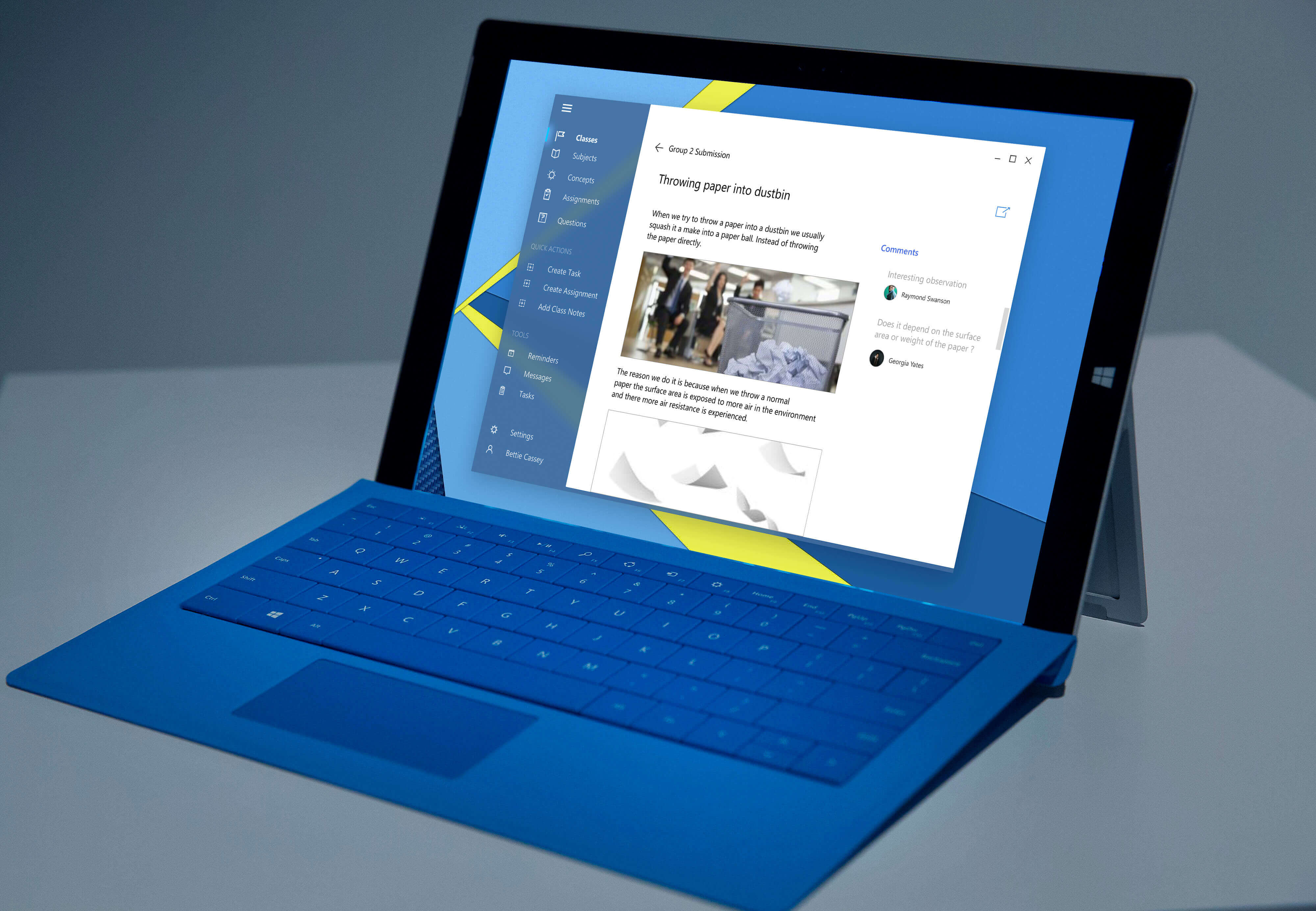
My Role
In this self-initiated project, I played the role of a User Researcher, User Experience Designer and User Interface Designer.
I had to really connect to the students, my users to know their practices in school, how they use technology and to what extent. I had to
look at their work to understand, how they interact with their teachers and other students in the class.
After gathering all the data, I had to wear my Information Architect hat to diffuse the data and give a meaning to it. I prepared heirarchial info-maps,
to make sense of it. Then as a user experience designer I prepared site maps, wireframes and eventually as a user interface designer I designed the application visuals on the Windows
OS design language.
Fixing The Scope
I had so much in scope for the project while discovering the needs of the students and teachers. While solving the problem of creating a student centred classroom and improving the existing structure of pedagogy. I was overwhelmed at the possibilities. However for the contraints of time and effort, I had to fix a hard boundary.
THE CHALLENGE
Empower Students
Most of the schools in India still follow traditional style of teaching. In the name of modernization some schools handover a digital tool like iPad or a tablet with digital content and expect things to change. To empower students is to improve their capabilities, giving the right environment and tools. We have to design systems that enable students to collaborate with other students, participate in more group activities. We should allow students to manage and organise their daily activities at school. There is need of a digital companion to enable this kind of digital transformation.
APPROACH
User Centred Design Process
I followed the User Centred Design process, in which I could gain insights into the students daily activities through
design research. I observed their goal and objectives to form personas. With the right understanding of the goals I could
get the requirements.
I did affinity mapping to categorize my observations and evolve a model which helped me
build the information architecture. I then picked few areas within the scope to proceed further to sketch user journeys,
wireframe, and eventually design the interface.
DISCOVERY
Student's Daily Activities
A Dairy is an integral part
I interviewed 4 students and 2 teachers during the research phase and asked questions about the school
activities, assignments, home works, project works.
I realised a school diary is an essential
part of student's day. They use it to record the assignments, plan the day, record observations,
to ask questions to the teacher etc.
However diary has some shortcomings:
- There is no way to collaborate on a diary.
- It is not shared with other students.
Teachers take all the workbooks, sketchbooks and project work for
evaluation and never returned to the students for later reference.
Class notes are either dictated by the teacher or marked on Class notes are either dictated
by the teacher or marked on x
Classrooms in Singapore are student-centered and stress on the
self-learning abilities of students where teachers play a role
of facilitator or guide.


My field notes from the interaction with students, teachers and parents and daily planner in the diary
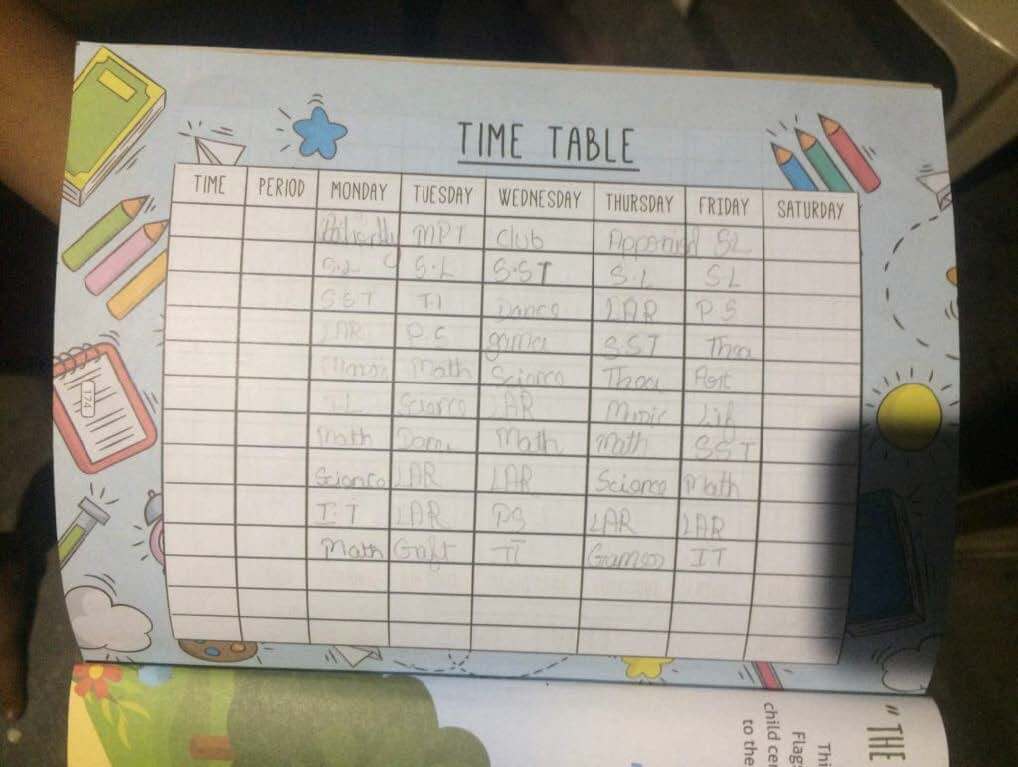

Exam planner and Day time table
AUDIENCE
User Persona
To get a clear picture for who this solution is being designed for, I created a user persona.
I could decide what is necessary or unnecessary for the audience easily thinking from from a user-centered point of view.

THE PROBLEM
Identifying the pain points
I have listed the pain points around the existing school diary,
its utility with respect to the motivations of the persona and considering the responses from the research.
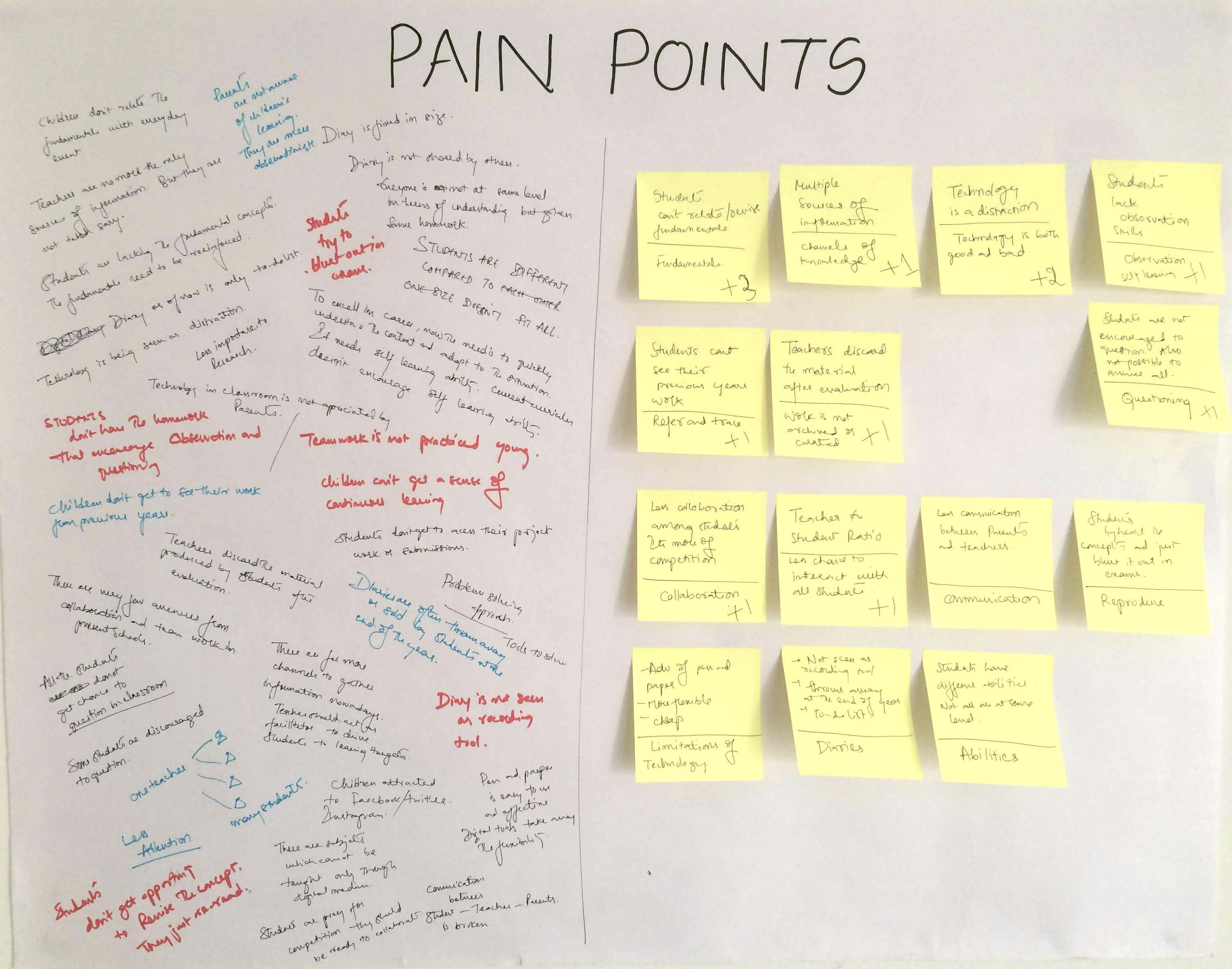
Some of them are :
- Students are unable to relate the concepts taught in school to the real world scenarios
- Concepts should be treated as tools and the whole focus should be on identifying and solving the problem, not the other way round.
- Technology is treated as adistraction by parents.
- Rarely students are encouraged to observe and question but are focussed on grades
- School diary is treated as a to-do list given by teachers, not as a journal where every day learnings are recorded.
- Most of the students don’t have access to the work they have submitted in the previous years.
- Students don’t have a holistic view of their appraisal in academics. Often it is viewed discreetly from year to year.
- School diaries become obsolete and are discarded by students at the end of the academic year.
- Often teachers also discard student’s project submission at the end of the year.
- Very less collaboration is required in the everyday academics. Students have to proactively form groups to work on projects.
- A one-to-many relationship between teacher and students discourages personal attention and fewer questions are answered in class.
- Different students have different abilities and cannot be ranked with common benchmarks.

I sorted the most similar pain points and categorized under key groups
- Fundamentals and Knowledge
- Abilities and Activities
- Communication
- Technology and Tools
The key categories gave me a clear understanding of the issues
around current day classroom education and the limitations of a diary
Key problems to be solved :
- Make students self-learn and be research oriented
- Make students ask Questions frequently
- Make students collaborate more with other students
BRAINSTORMING
Solving the problem
Listing the ideas
Some of the ideas were very detailed while some of them were at high level.
I withheld any critical view and tried to have a free flow of ideas uninhibitedly.
However, I could get a sense of where I was going with respect to the solution.
I was focusing more on the quantity of the ideas rather being subjective about them.
Most of the ideas were revolving around a platform where students can assimilate the knowledge about
the concepts taught in the classroom, reinforce the concepts from their own understanding and observations etc.
I later categorized the ideas with an intention to find relations and help me get a general structure.


Affinity Mapping
Then the ideas are sorted into groups and subgroups based on associations and subsequently reveal the theme of the solution.
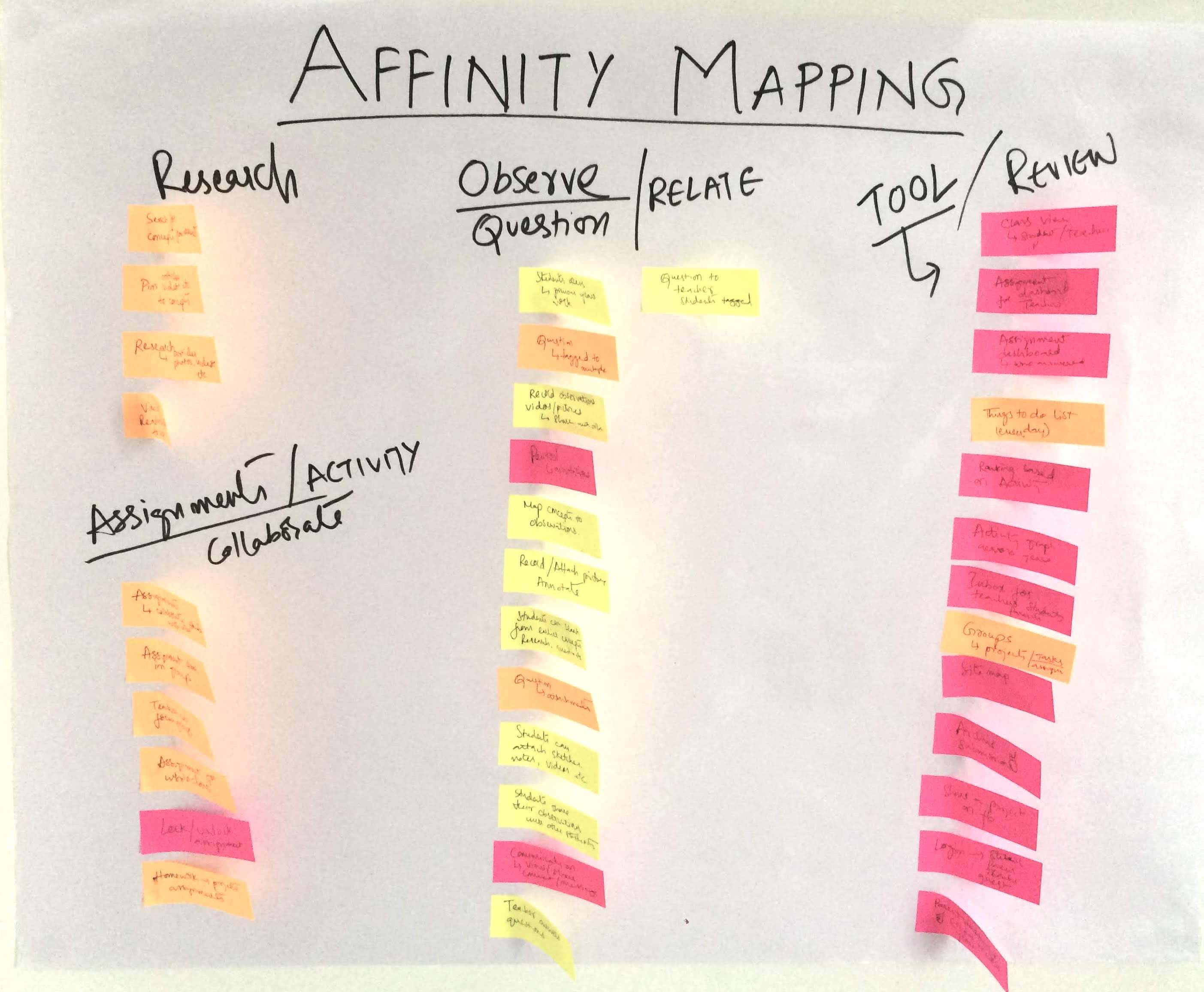
THE SOLUTION
Zeroing down
Most of the ideas were revolving around a platform where students can assimilate the knowledge about the concepts
taught in the classroom, reinforce the concepts from their
own understanding and observations etc.Then the ideas are sorted into groups and
subgroups based on associations and subsequently reveal the theme of the solution.

A relationship model that can give a high level interaction betiween the stakeholders
Solutions:
- Explore more about the concepts taught and grasp it completely.
- To record the observations in the real-world scenarios and trace
it back to the fundamental concepts learned.
- To raise questions without inhibition and get answered.
- Collaborate with other students for group assignments.
- Aid teachers to communicate effectively with students.
STRUCTURE
Information Architecture
Finally, I arrived at a structure which elucidates the solution as a centralized student platform
which has several layers like:
- Research – Where student explores more about the concepts by browsing through example videos, sounds, articles, and illustrations.
- Retain – The student retains the new found knowledge by solving assignments and tasks around it, often given by the teacher
- Relate – The student can record the observations in his/her everyday scenario ( in the form of pictures, videos, sounds etc) map them to the concepts across subjects.
- Revise – During this process, students can revise concepts learned in previous years, browse through their submissions, or answers.
- Collaborate – Students can share their research, findings, observations with other students. They can submit assignments as groups, comment on each other submissions. It is more empowering to share results with each other.
- Teacher-Student Relationship – There is effective communication between student and teacher. The teacher can assign tasks, give remarks, answer questions, evaluate the submissions and more.
- Parent – Student Relationship – Platform allows parents to track the progress of students with a holistic view rather than a discreet academic year wise review. Parent and teacher share an inbox to communicate.
- Communication layer and Dashboard views enable teachers and parents to track the progress and activity ranking of students.
- Multimodal interaction using a pen tool or touch.

Use Cases
There are 3 primary users Students, Teachers, and Parents. I classified the use cases for each of the users. Some of them might involve more than one user.
Student use cases :
- Sign up and log in
- Browse through subjects and select a subject
- View concepts under a subject
- Find more content and pin content to concepts
- View or share research findings with other students
- Upload observations ( picture, video, sound, text )
- Annotate observations using a pen tool
- Comment on others observations
- Ask question to the teacher
- Form groups
- Collate research by the group
- Record observations as a group
- Submit assignment individually or as a group
- Comment on others assignment
- Search and view concepts from previous years
- View a student/ self-profile
- View class page
- View reminders / View calendar
- View/Edit/Delete/Check to-do list
Teacher use cases:
- Sign up and log in
- Share concepts under a subject
- Give references for a concept
- Ask questions to individual or group of students
- Assign tasks to students
- View submissions of students
- Evaluate a submission by individual student or group
- Answer questions
- View student profile and activity
- Message individual students
- Message parents
- View student dashboard
- View class page
- View inbox
- Create/Edit/Delete a reminder for student/class.
Parent use cases:
- View student dashboard
- View inbox
- Create/send a message to a teacher
- View student reminders
Due to the limitation of time, I will be considering only one of the possible user
scenarios for detailed interaction :
Teacher gives an in-class group assignment on a particular concept
A student comes across an interesting observation at home and explores further
A Student manages daily homework tasks given by teachers
I have taken the first one, where a teacher gives the students an assignment to be finished within 45 minutes in a classroom scenario. This promotes observational skills and also gives a chance to collaborate with other students to finish the task.
SCENARIOS
Teacher gives an in-class group assignment
on a particular concept
I have broken the challenge into 4 sub-tasks.
- The teacher creates an assignment
- Students work on the assignment
- Teacher evaluates the assignment
- Students comment on each others assignment
1.Teacher creates an assignment
Teacher lands on the classes screen of the platform after logging in.
Each “Class-Card” has a progress of how many concepts are taught.
I wanted this software to help teachers equally to manage their everyday activites along with students.
Hierarchical Task Analysis / User Journey:
- Teacher logs in
- Selects a class
- Goes to assignments for the class
- Create a new assignment
- Send a message to all students


Sketches to illustrate the scenario - Teacher giving an assignment to class

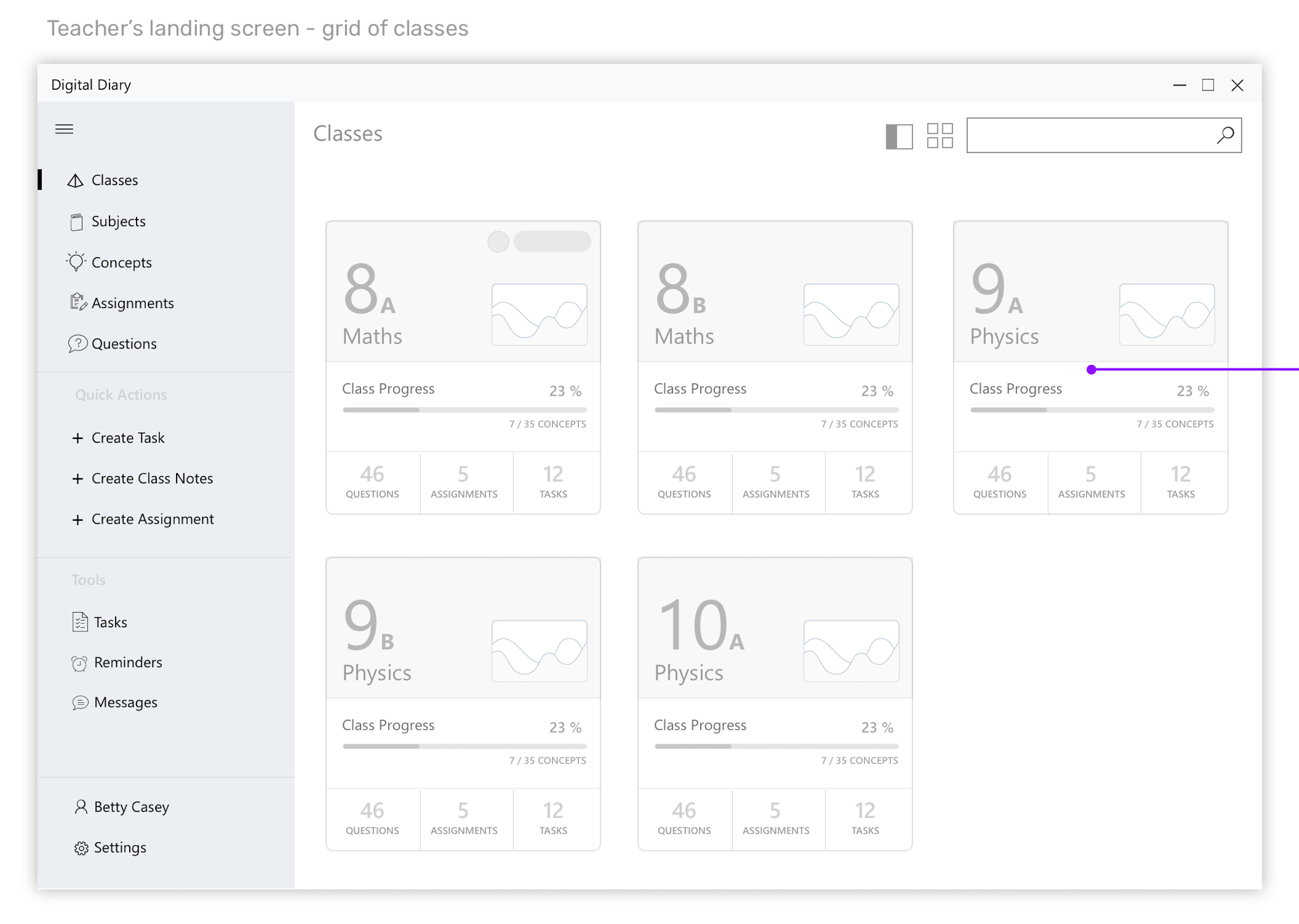
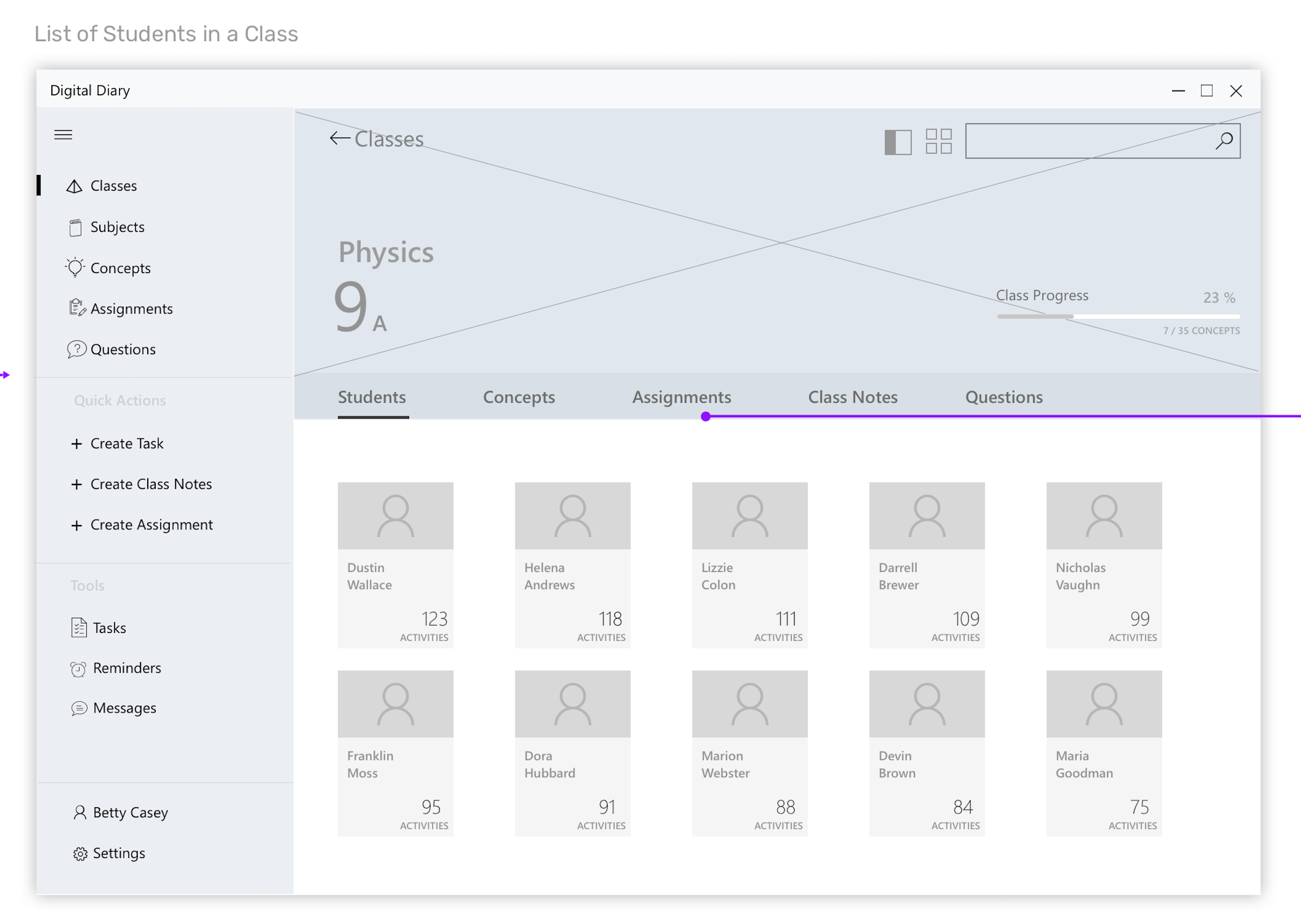
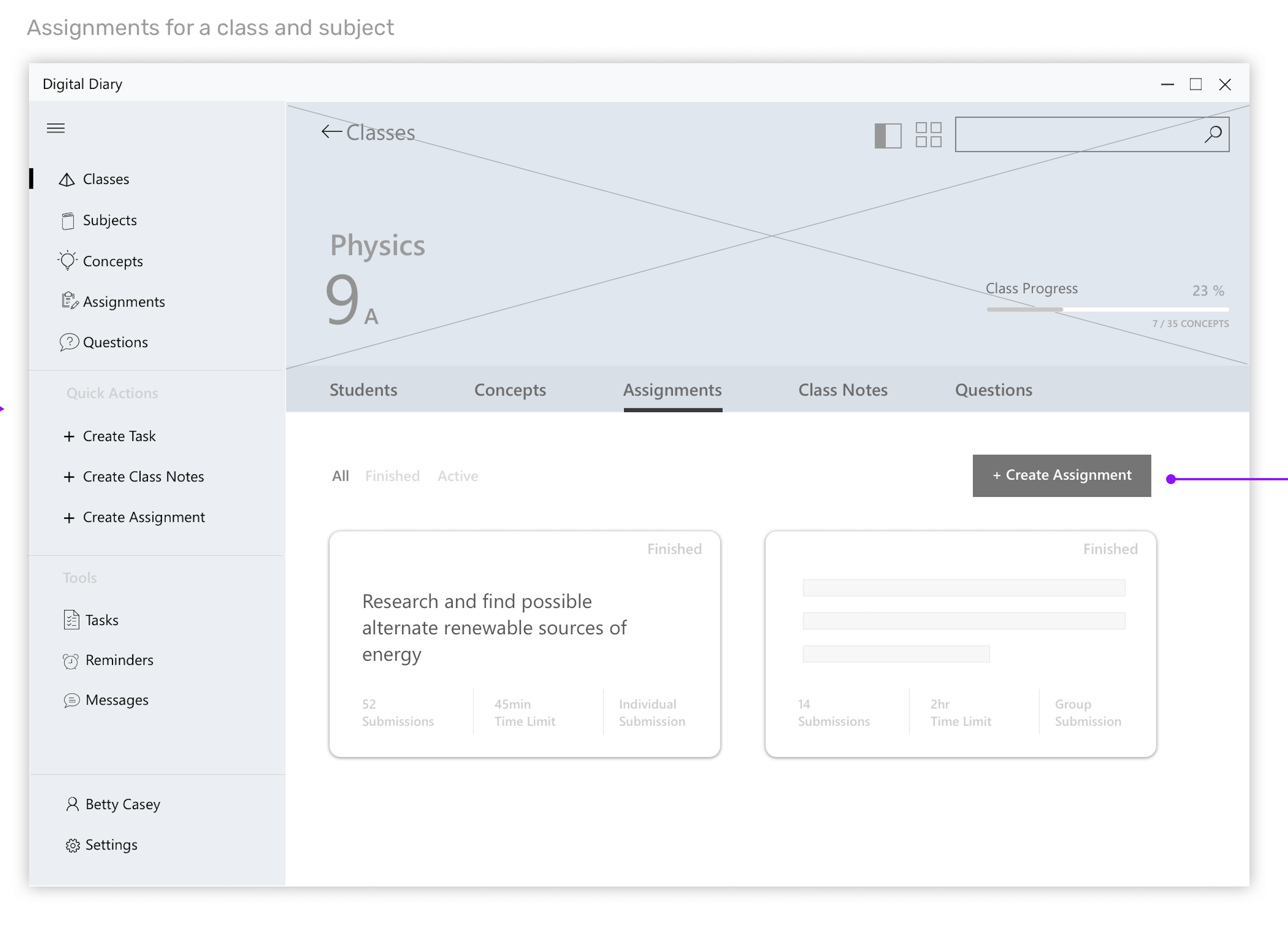
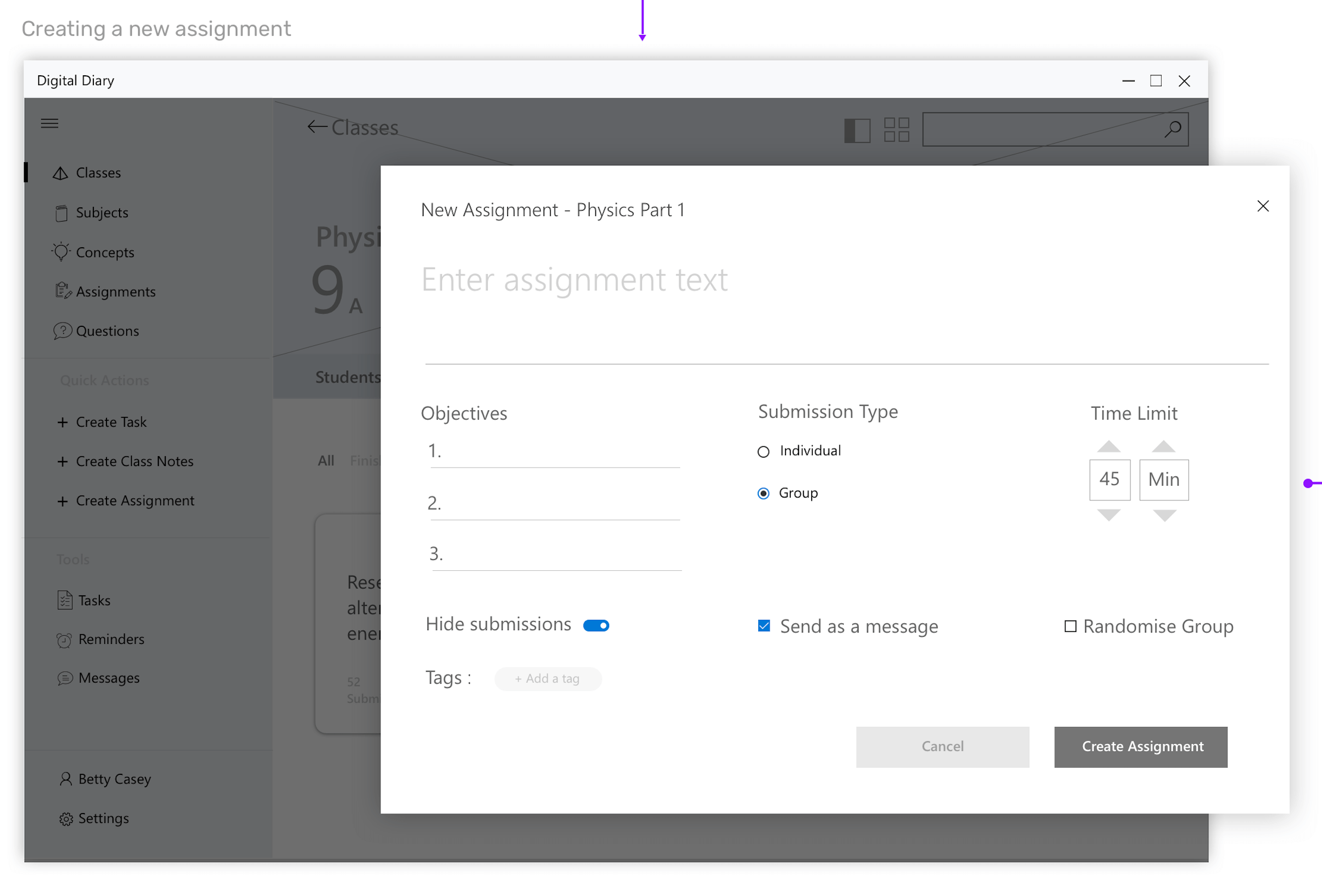
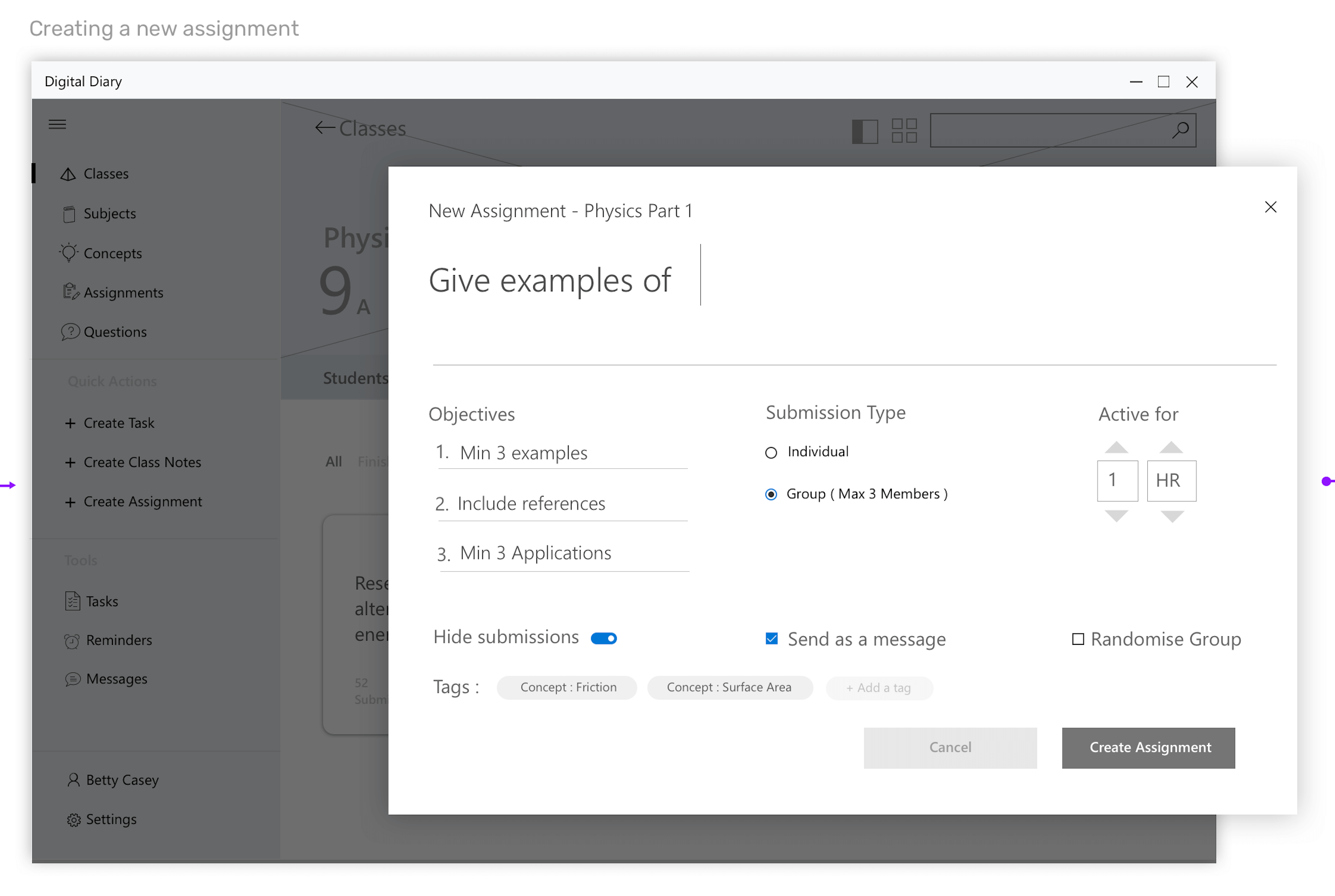
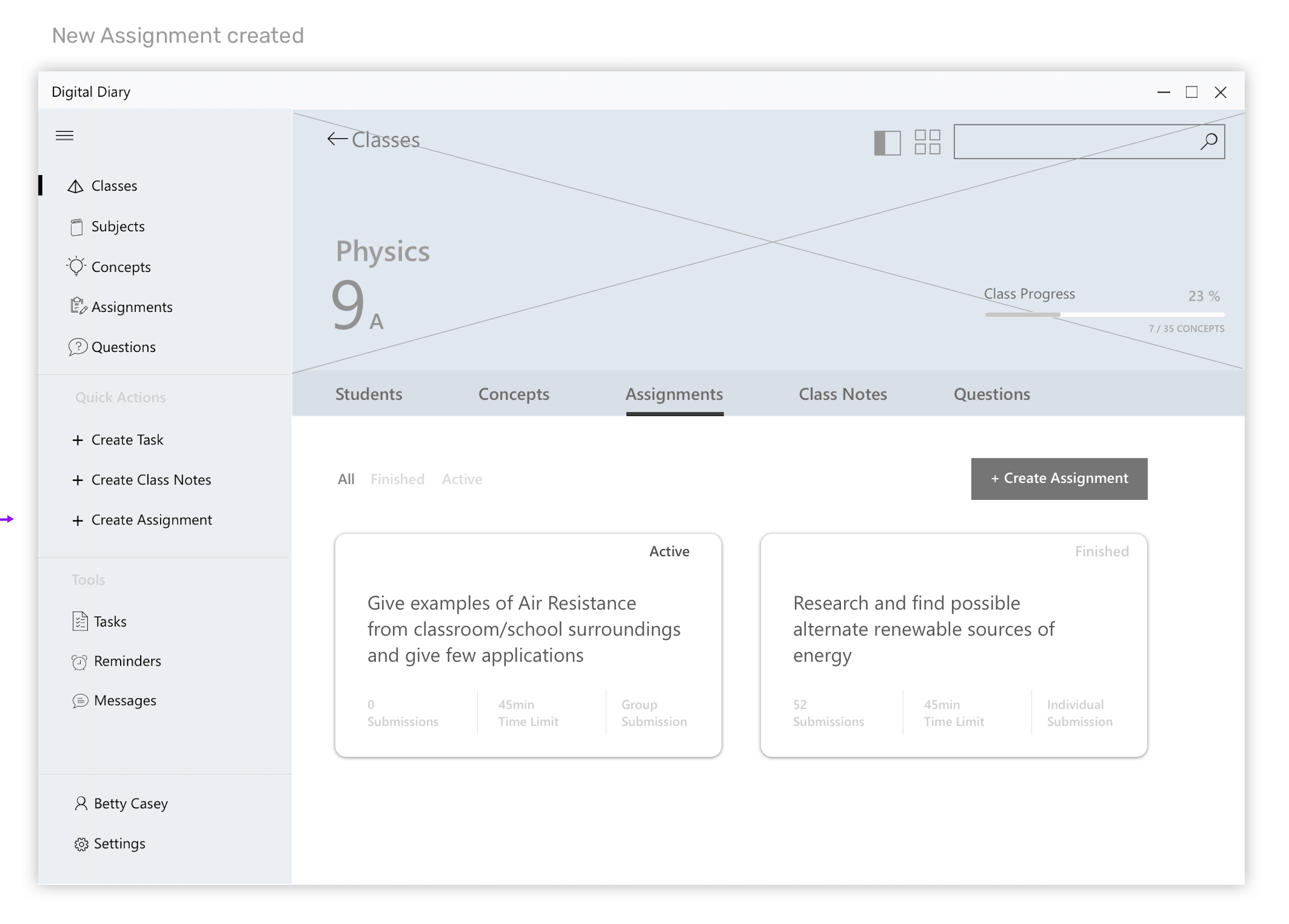
Wireframes for the scenario - Teacher giving an assignment to class
2.Students work on the assignment
Students login and land on the Subjects page. They can select a subject and view the assignments. Also there is a notification for any new assignments.
Hierarchical Task Analysis / User Journey:
- Sees a message about the new assignment
- Open assignment page
- Invite other members to form a group
- Work on the assignment
- Submit the assignment
- Teacher evaluates the assignment

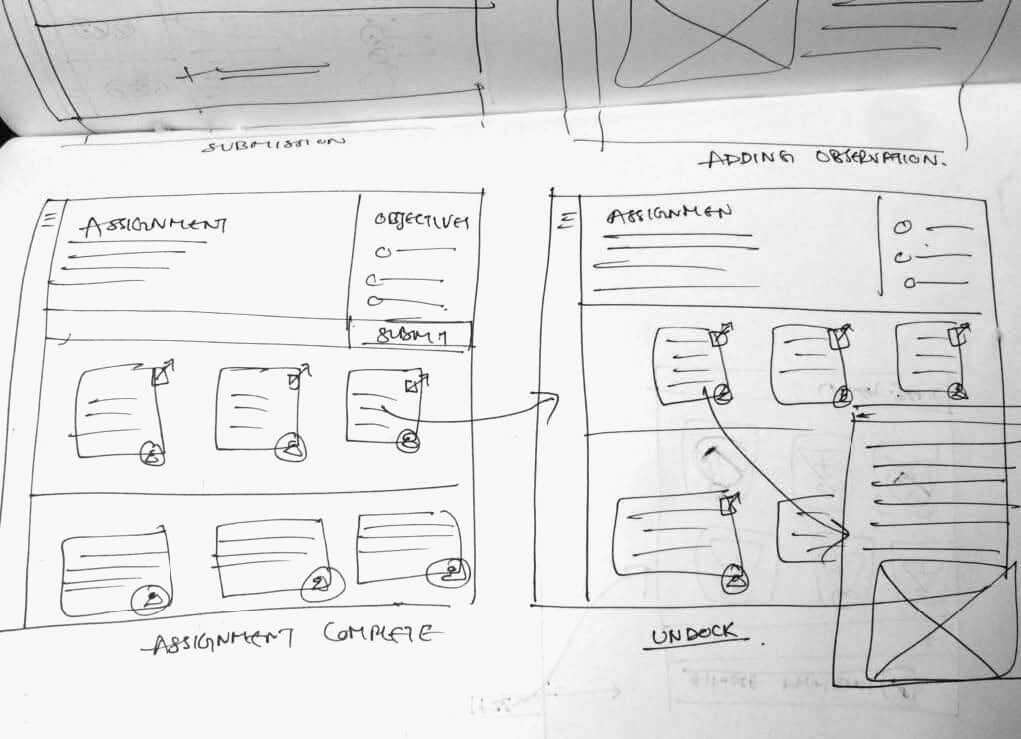
Sketches to illustrate the scenario - Students work on the assignment
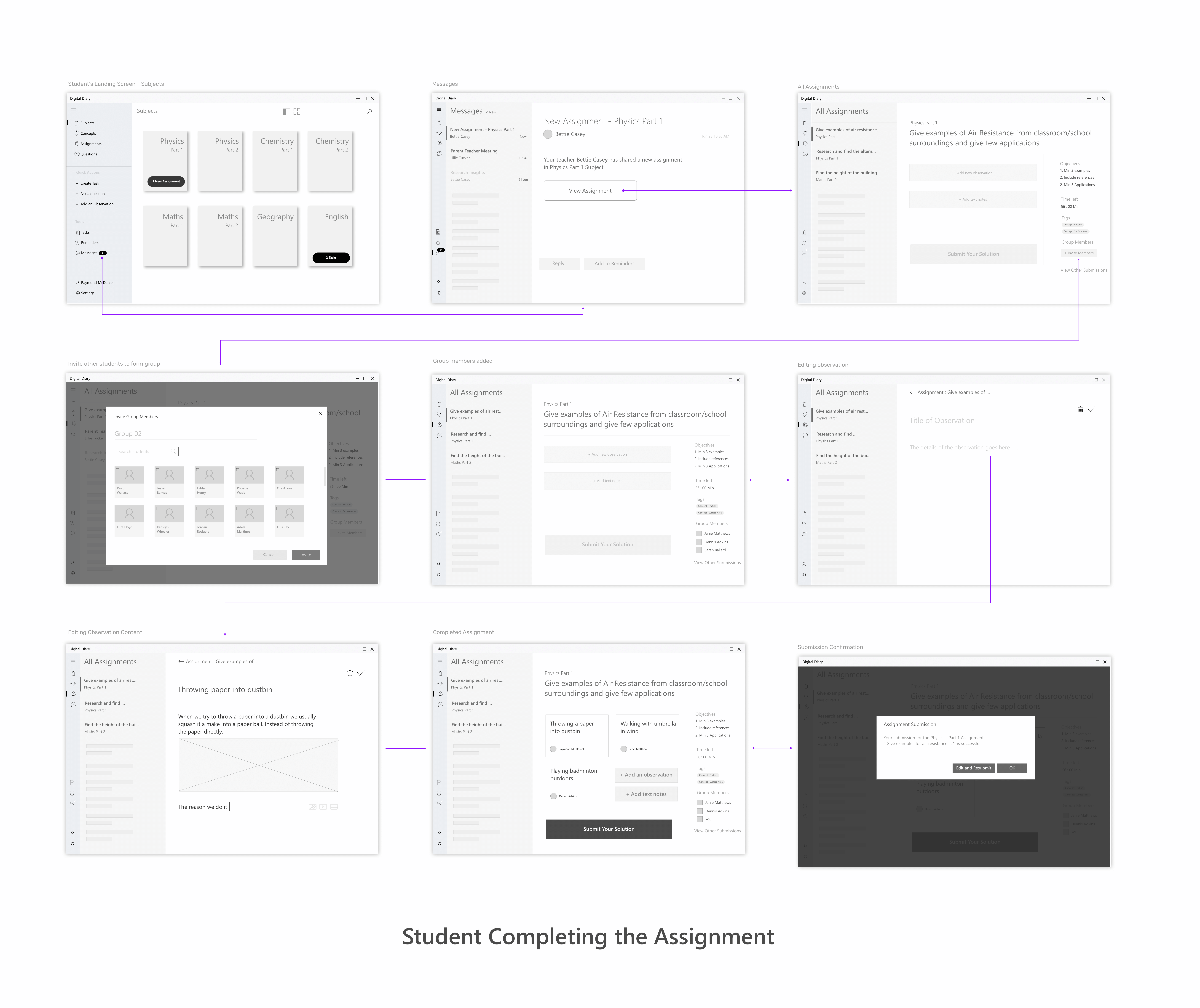

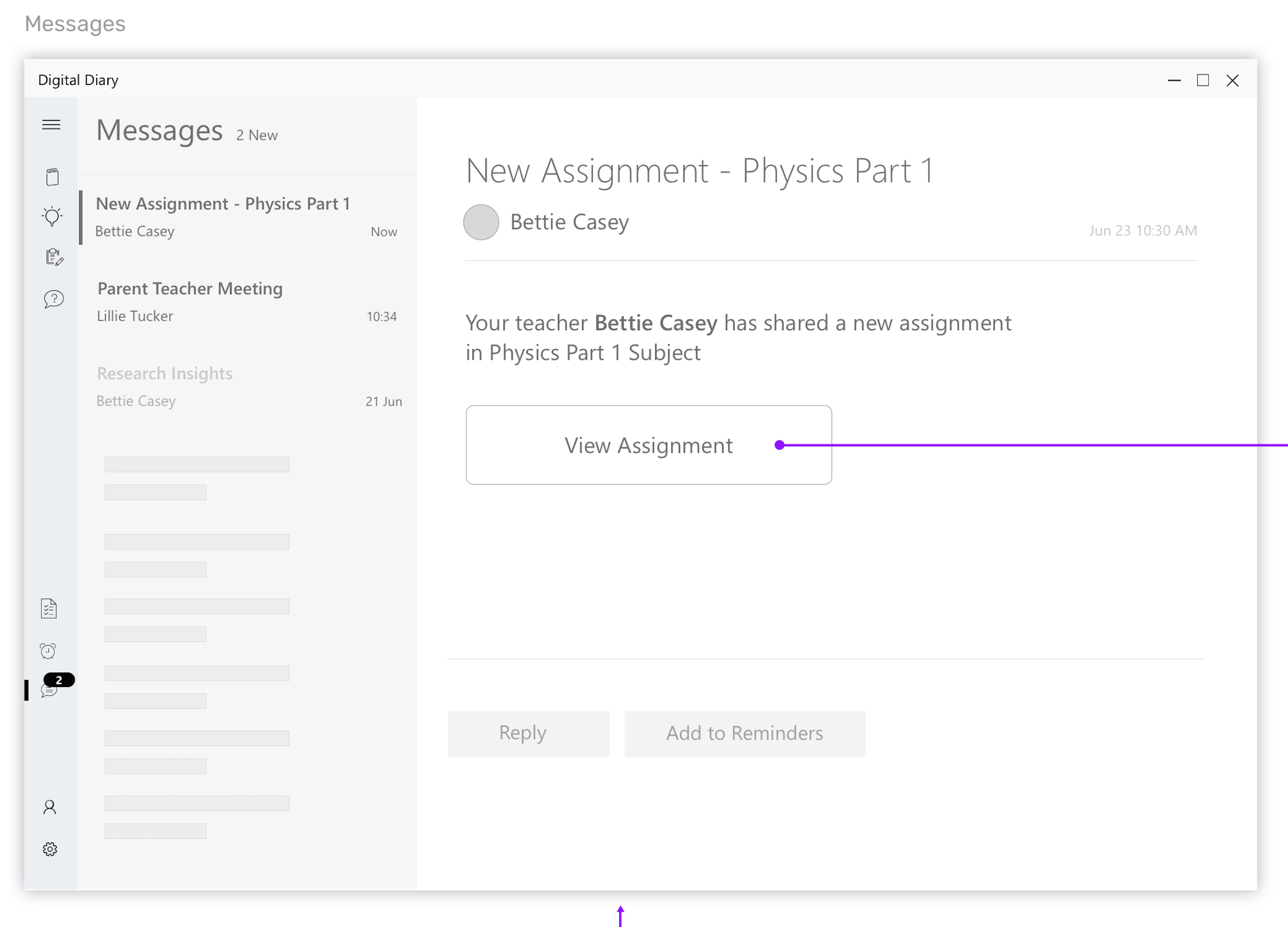
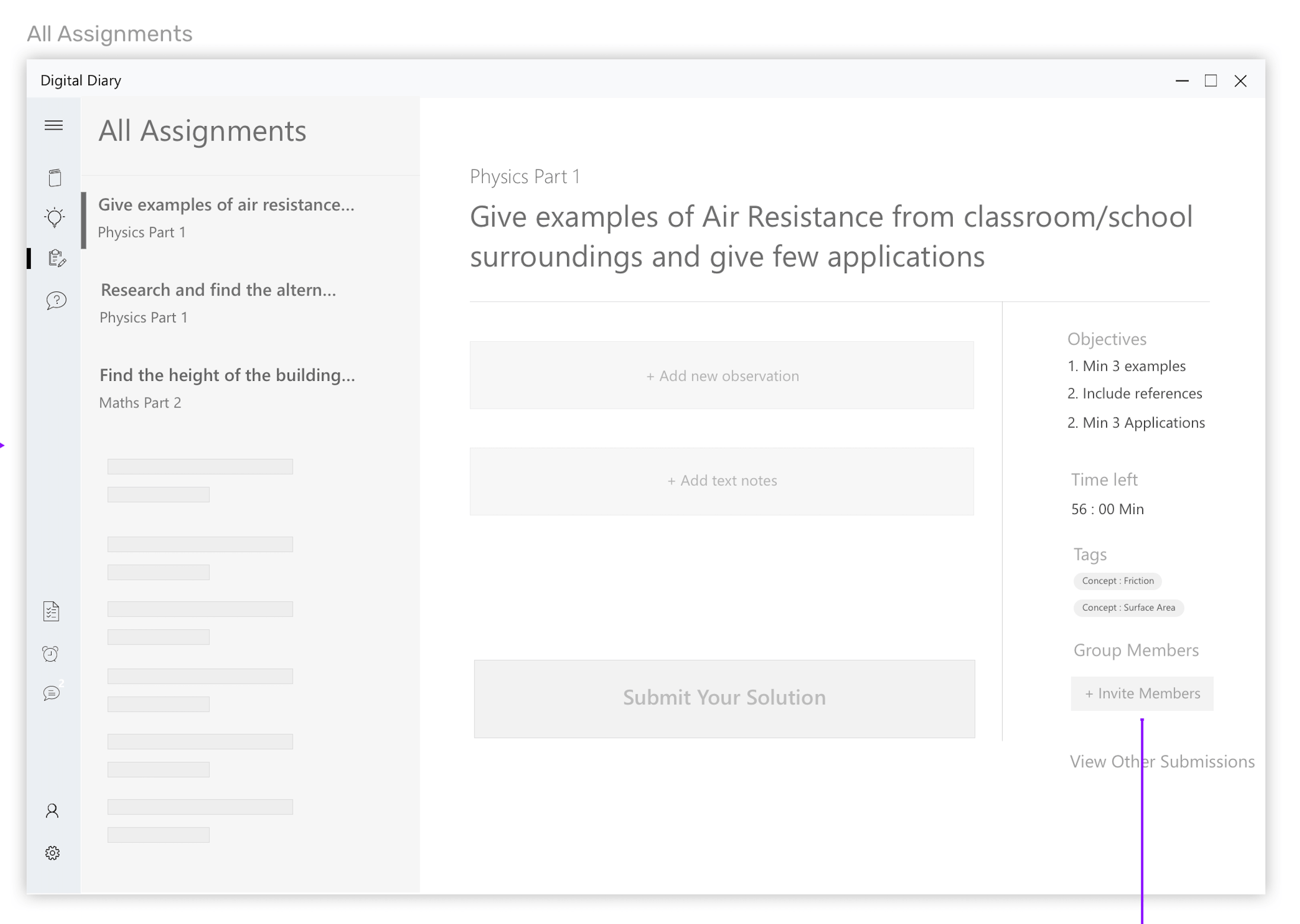

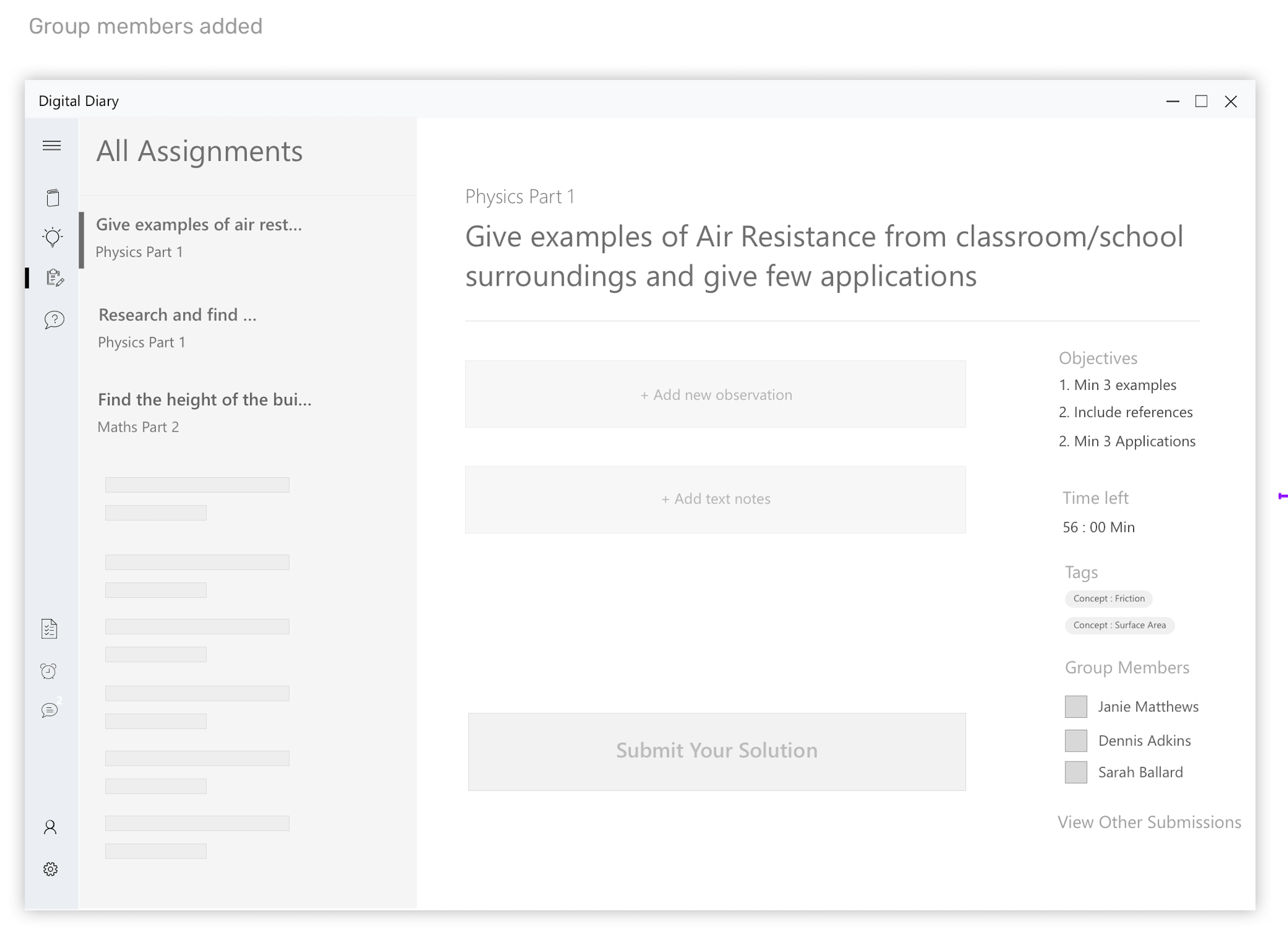
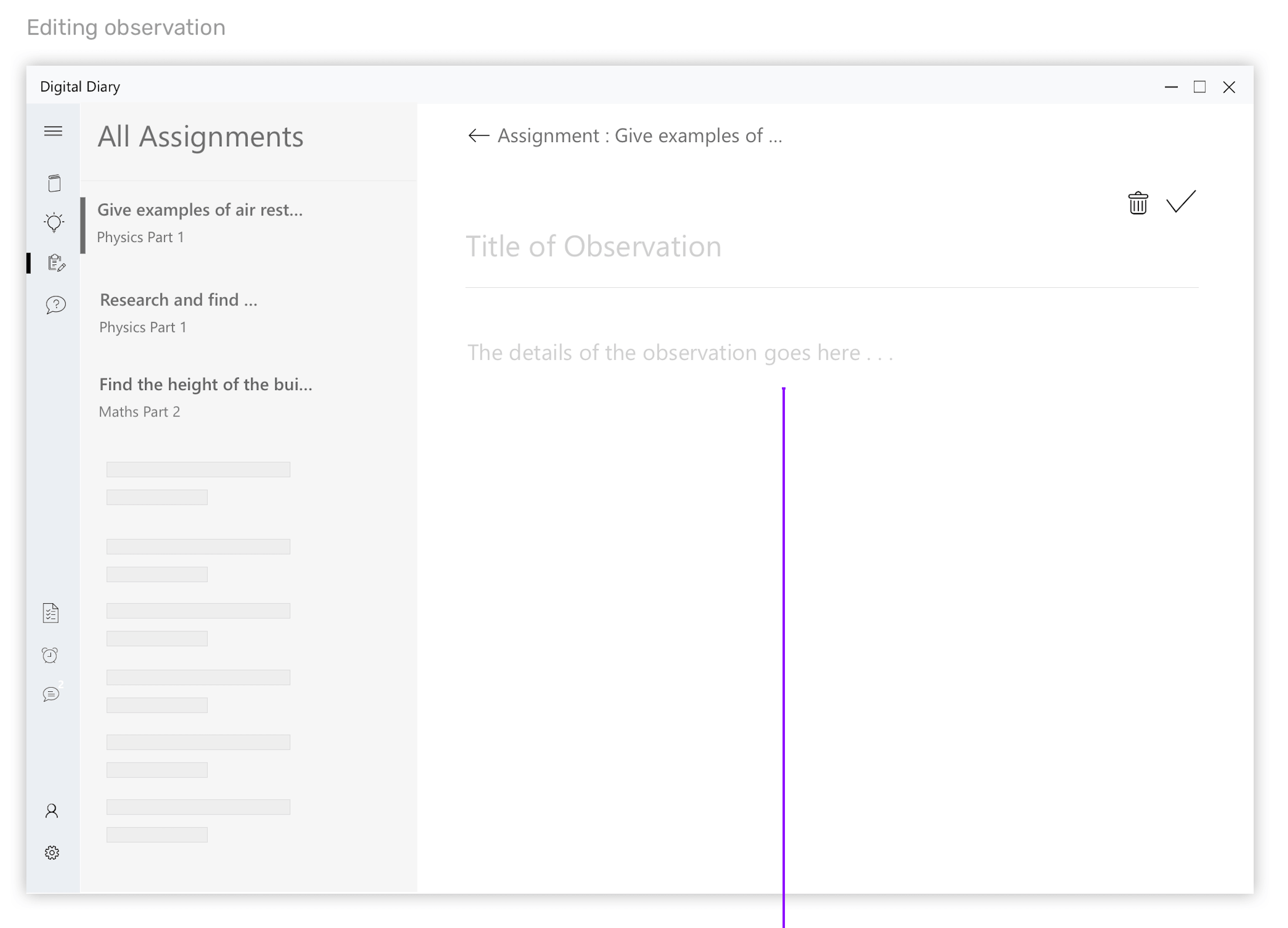
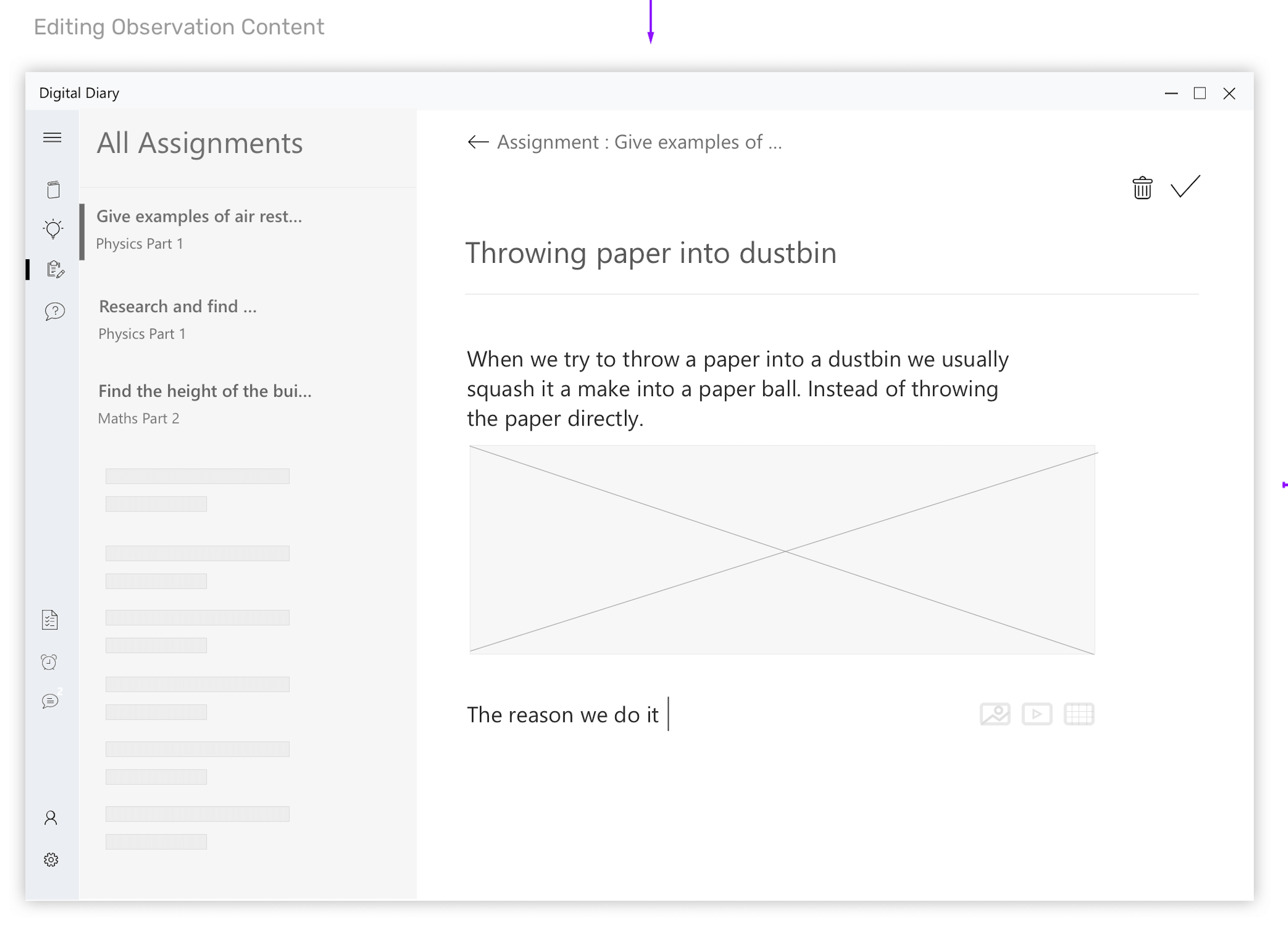
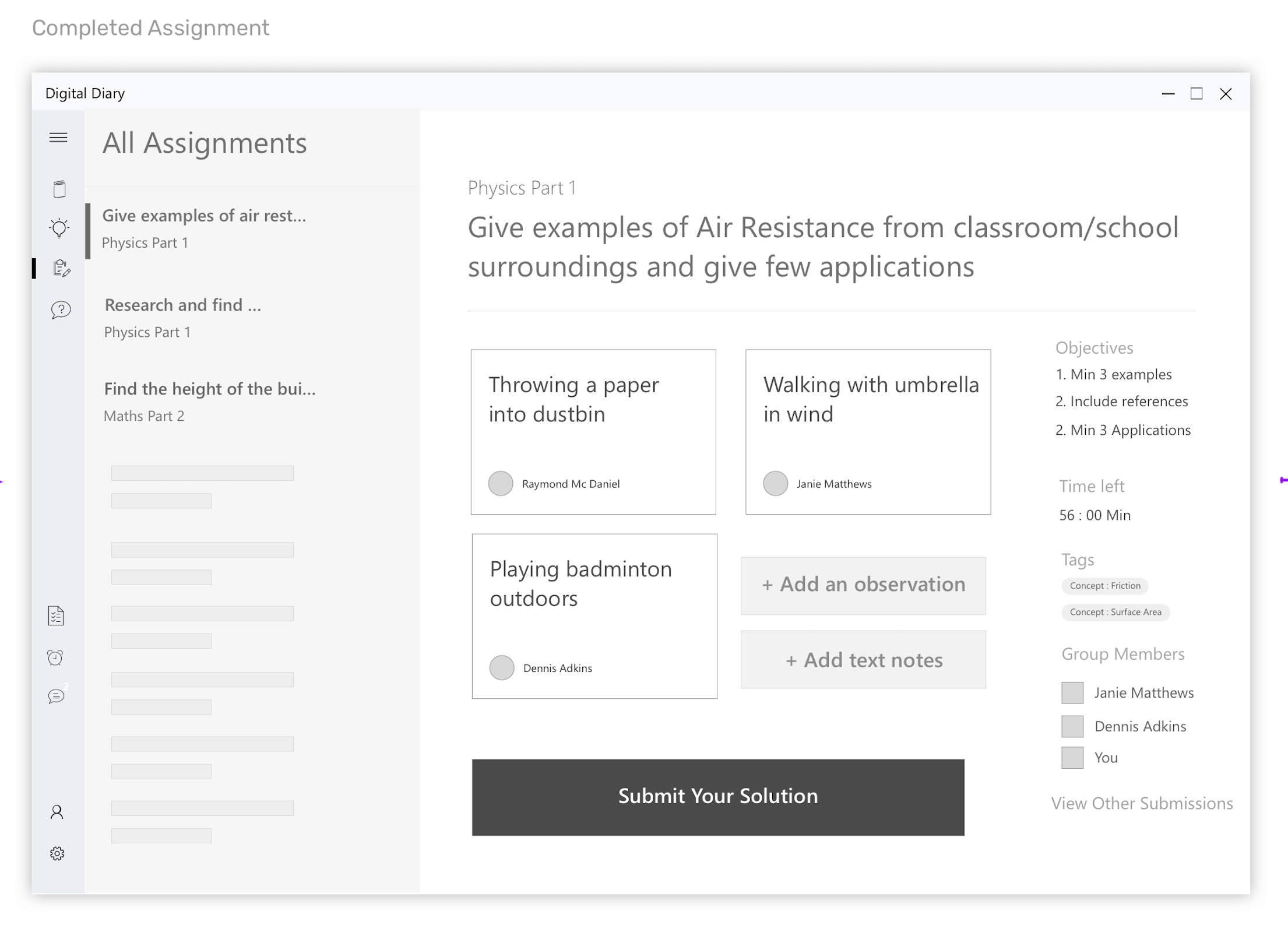
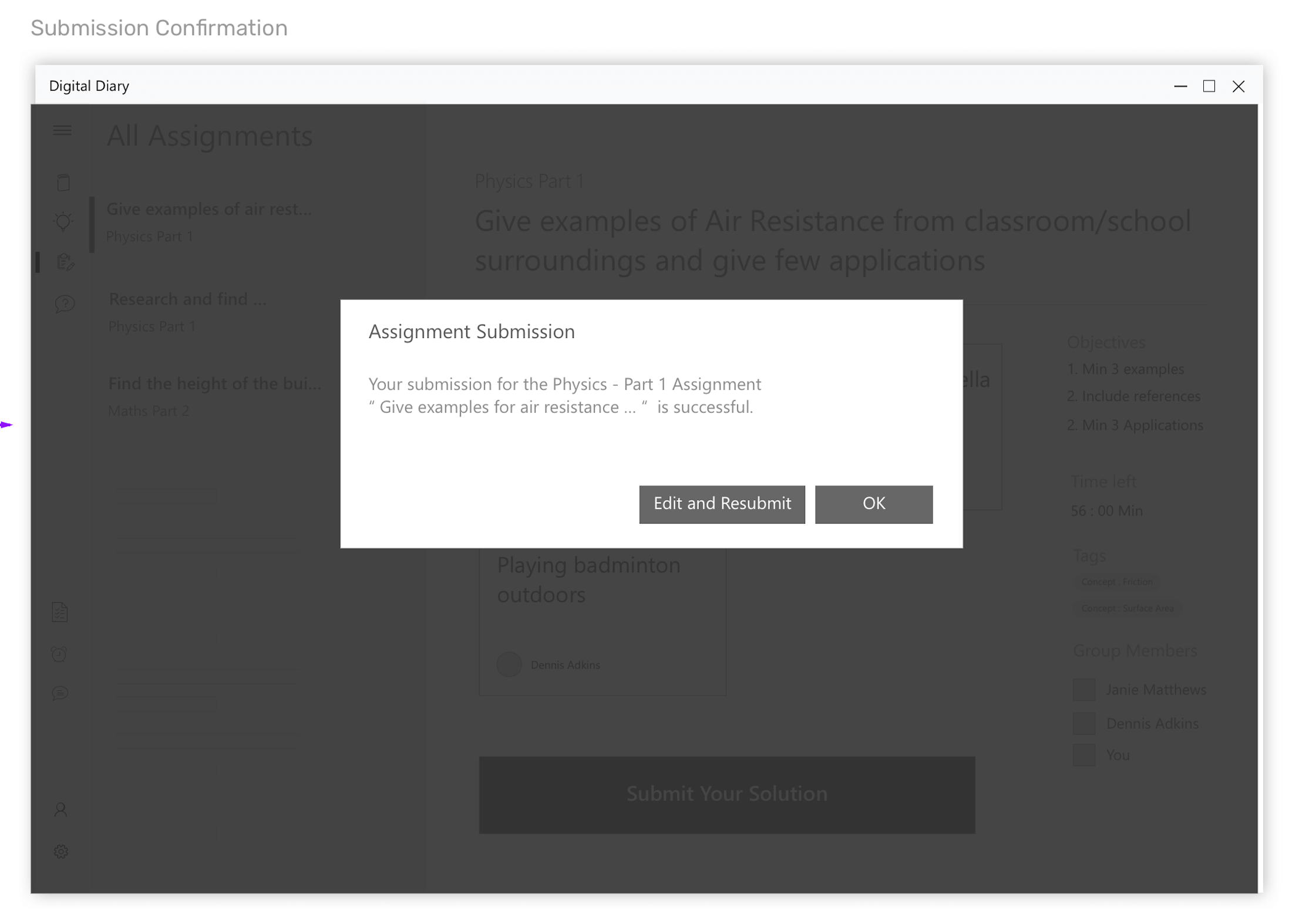
Wireframes for the scenario - Students completing the assignment
3.Teacher evaluates the assignment
Hierarchical Task Analysis / User Journey:
- Checks the submissions by various groups
- Open each submission
- Evaluate each submission
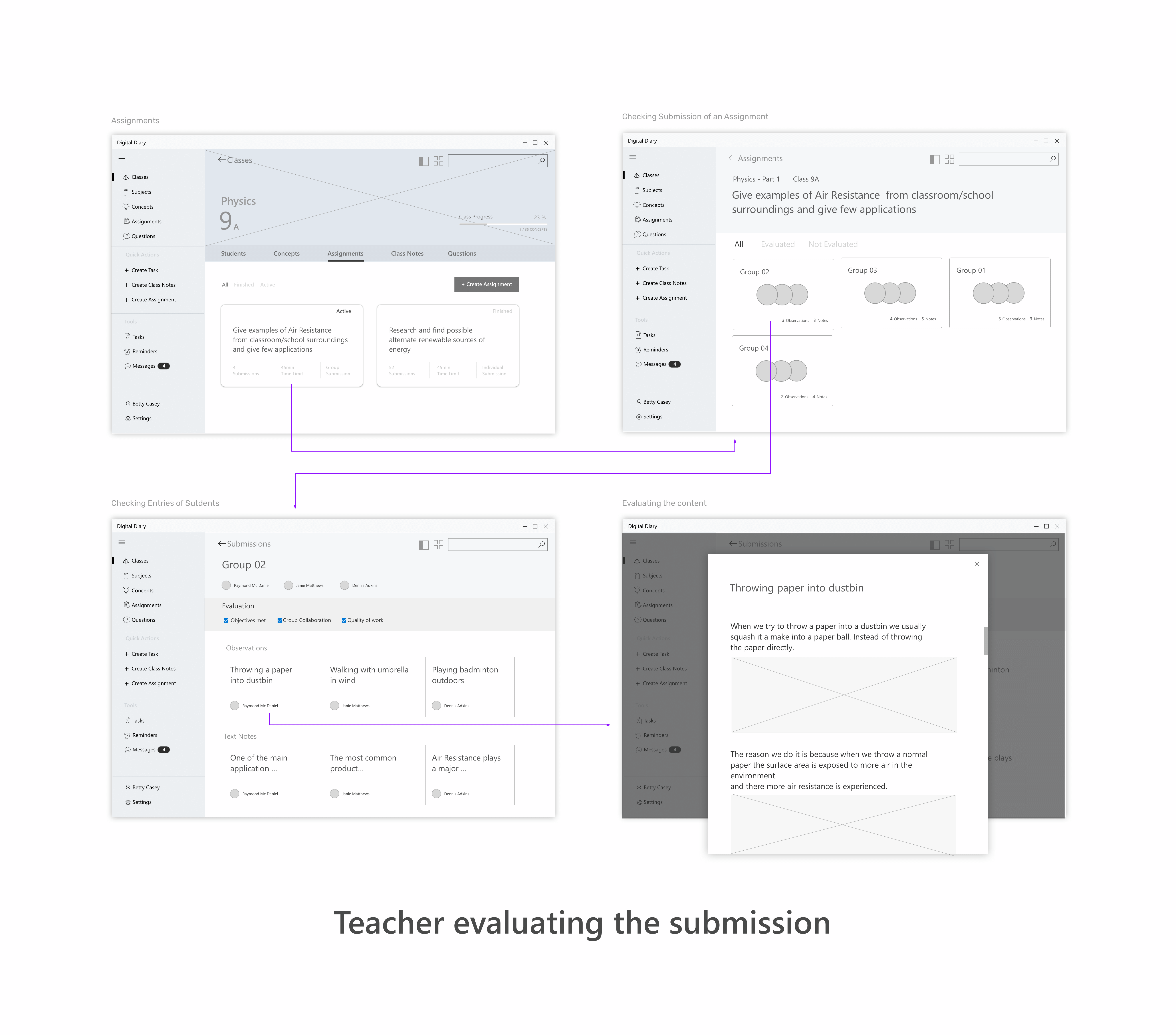

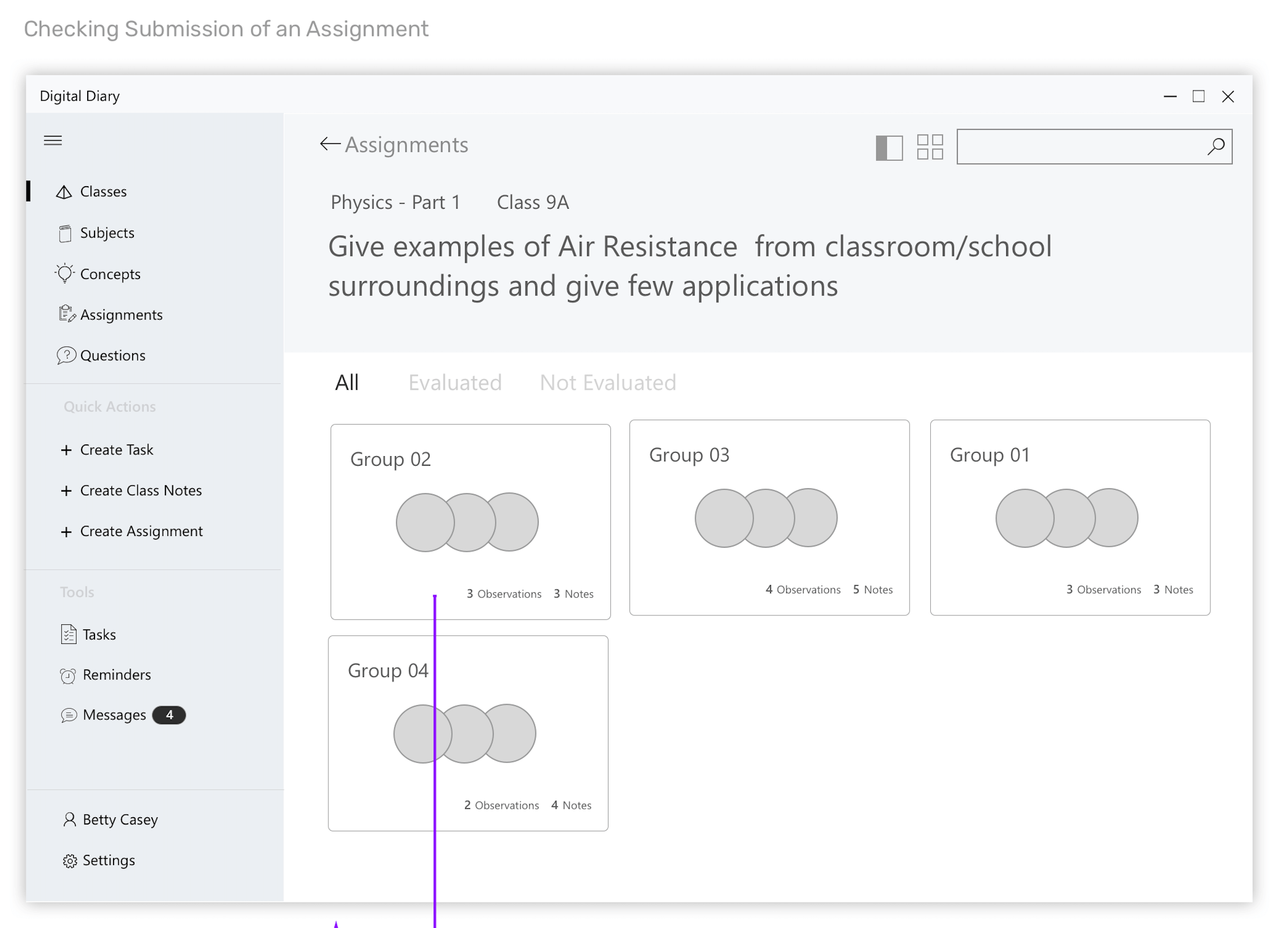
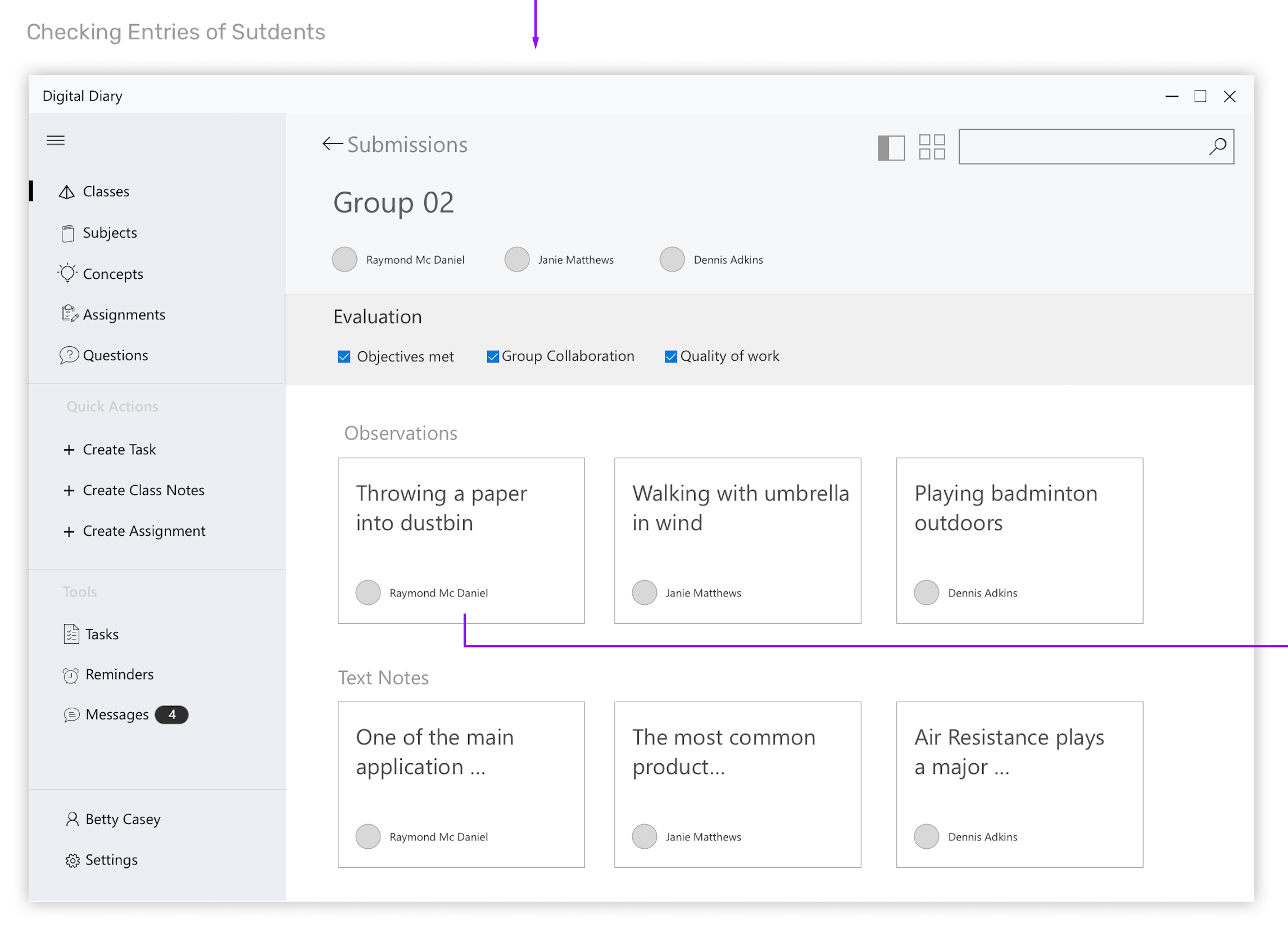
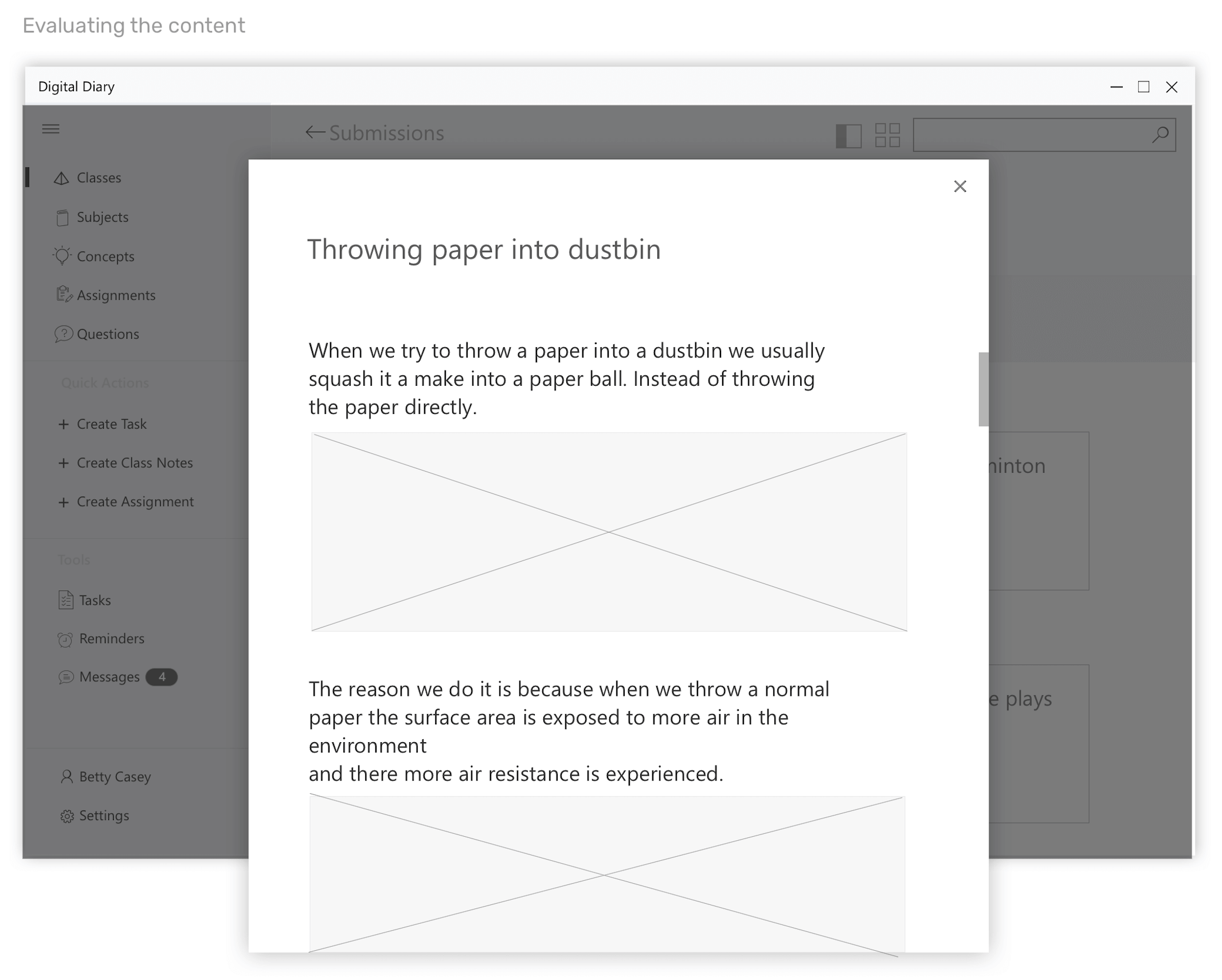
Wireframes for the scenario - Teacher evaluating the assignment
4.Students comment on each others assignment
Hierarchical Task Analysis / User Journey:
- Students check other’s submissions
- Comment on each other’s submissions
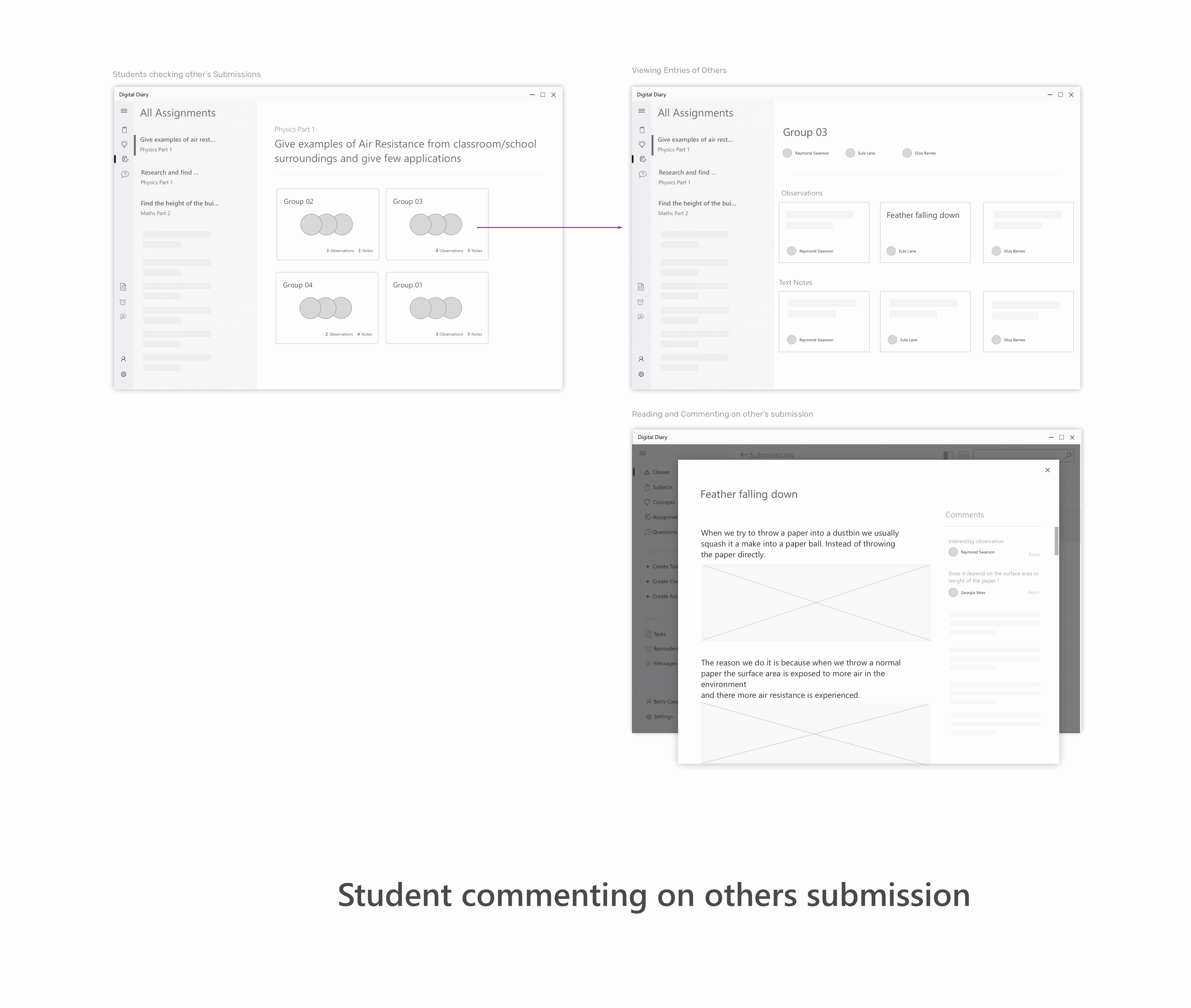
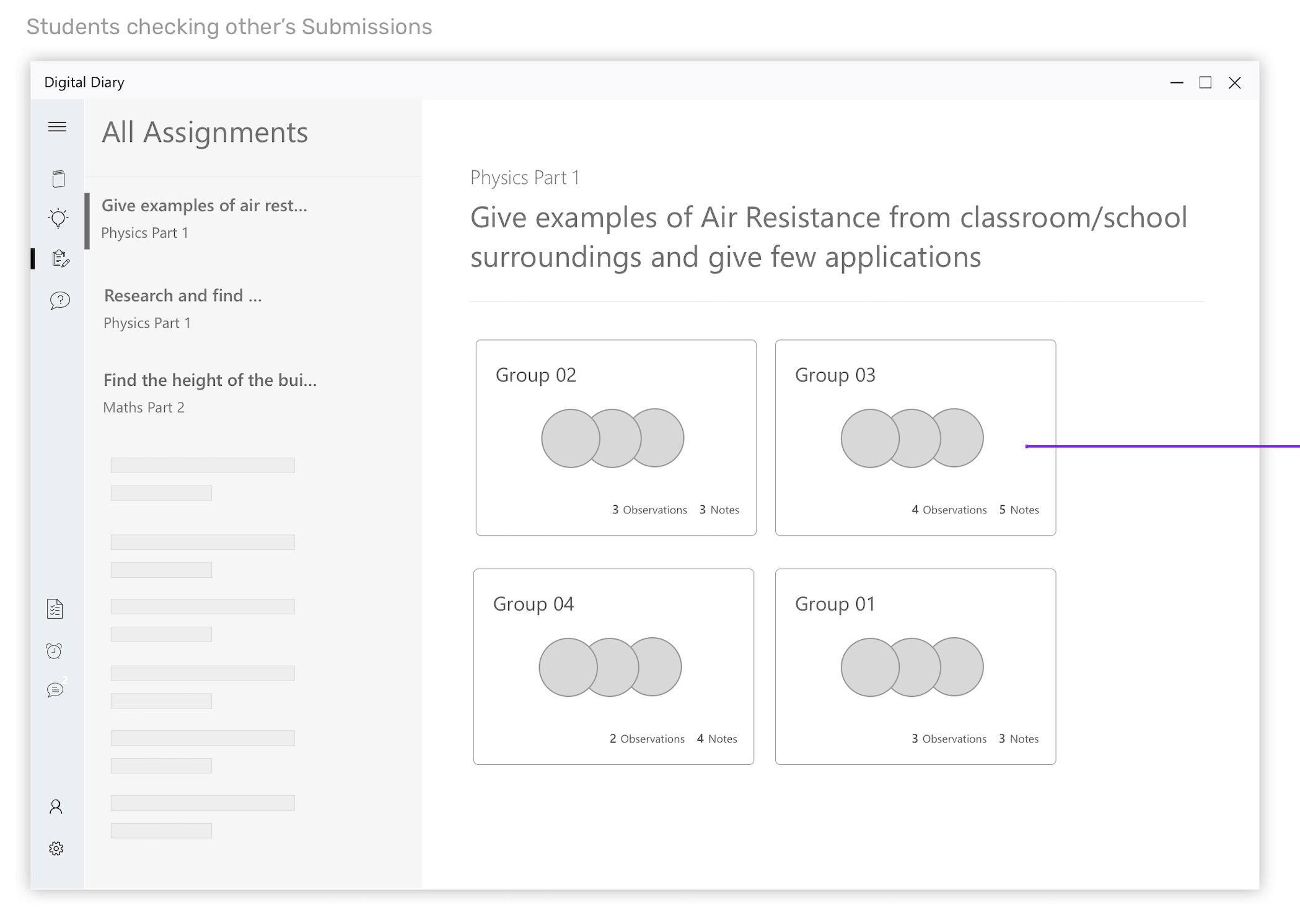
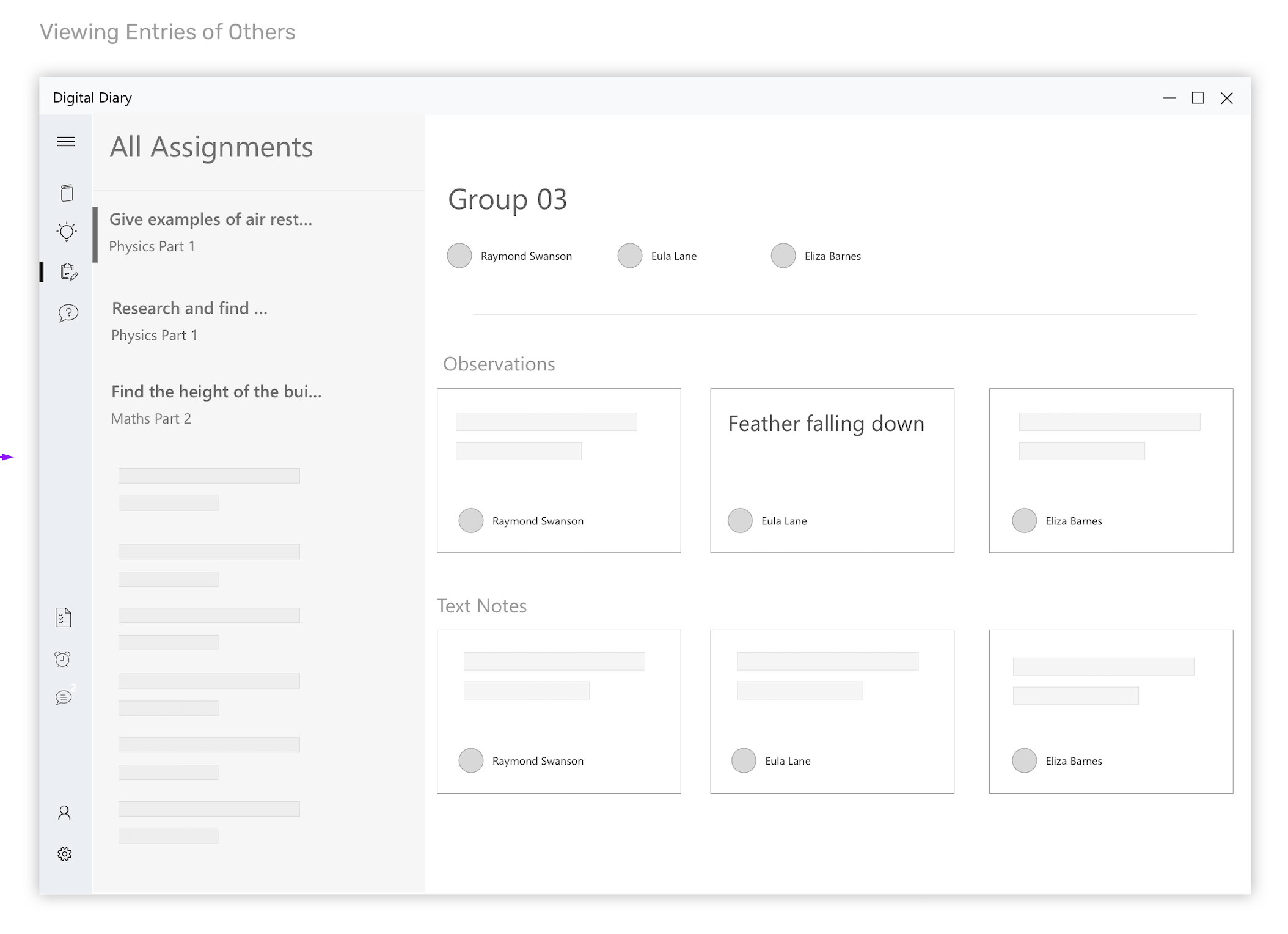
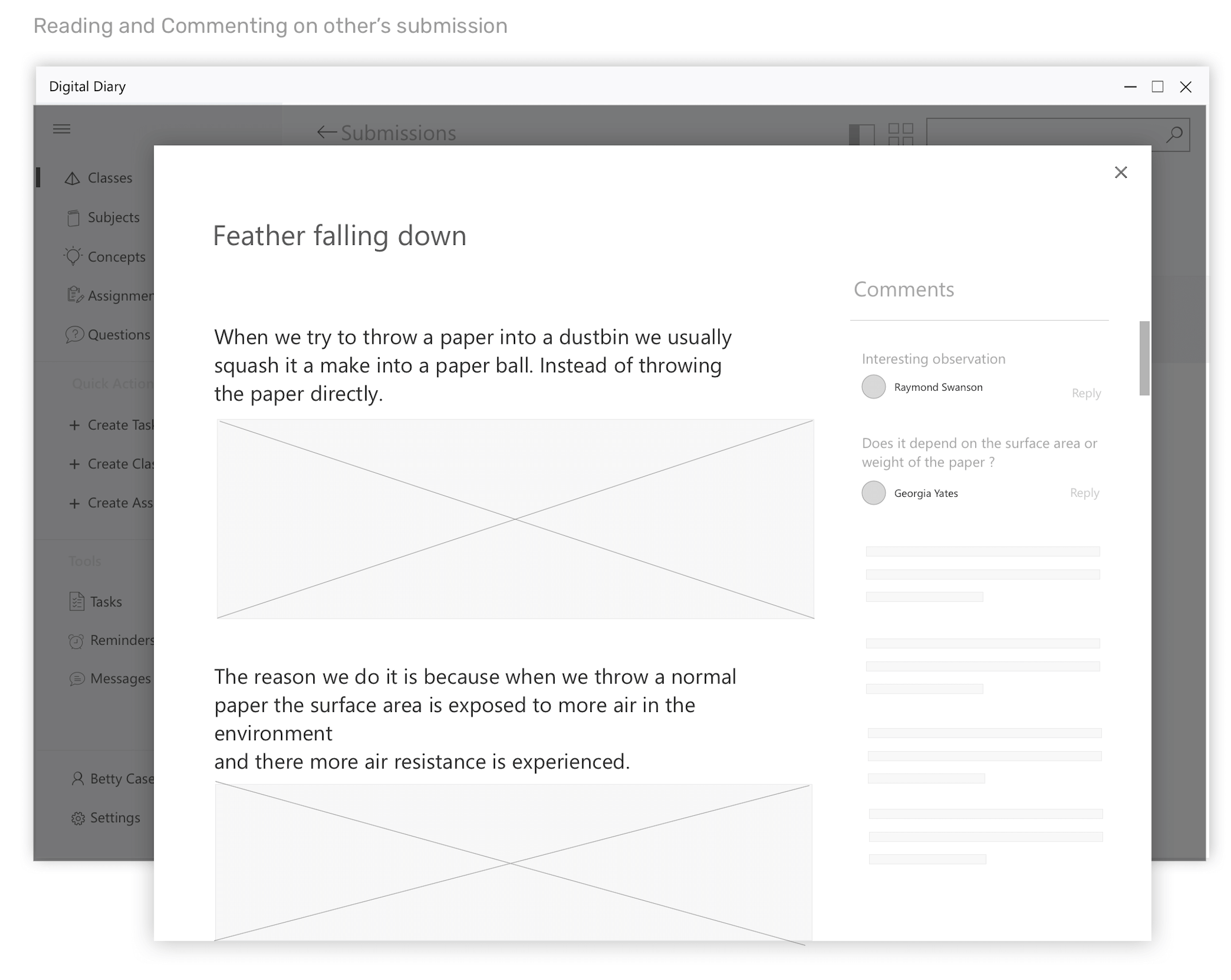
Wireframes for the scenario - Students commenting on each other's submissions
VISUAL DESIGN
Fluent Design System
I adopted the Fluent Design System, as most of the students carry Microsoft Windows OS based digital tools like laptops.
Fluent is an open-source, cross-platform design system that gives a framework to create engaging experiences.
Class

Teacher lands on the classes screen of the platform after logging in. Each “Class-Card” as a progress of how many concepts are taught. I wanted this software to help teachers equally to manage their everyday activites along with students.
Students in a class

The teacher can view various facets of a class. I have shown only a couple of them here.
Students tab has all the students sorted by the
number of activities one has performed.
I felt Activities ( recording observations,
participating in group assignments, adding notes during research etc ) is a better
measure than performance in examinations. So I gave more emphasis on the Student – card.
Assignments

For a particular class, only the relevant assignments are shown.
The teacher can create a new assignment from here. For each Assignment, there will be two states :
1. Active – which means the assignment is on-going and still accepting submissions from students
2. Finished – Apparently, the assignment is not accepting any new submissions
Also, each assignment can be taken by a Group or Individual.
Messages

The student checks the message about the new Assignment.
Student's Assignment

Student checks the message about the new Assignment and proceeds to work on the assignment.
From here, student can invite others to work on the assignment View other’s submissions, or start working.
Invite to a group

The students wanted to work on the assignment in a group and invite 2 more members to participate with him/her. On the list to choose members, we can eliminate those who have already formed groups.
Adding content

Since the assignment is set up in a classroom, students can come together and discuss the various concepts, experiences and update the observations section. By this, we ensure collaboration is fruitful among the students.
Submission

Once the student feels the assignment is ready for submission can check if it meets the desired objectives.
Teacher recieves submission

There are di!erent groups who submitted for the assignment. They are sorted by the chronological order. Those submitted first will appear first on the page.
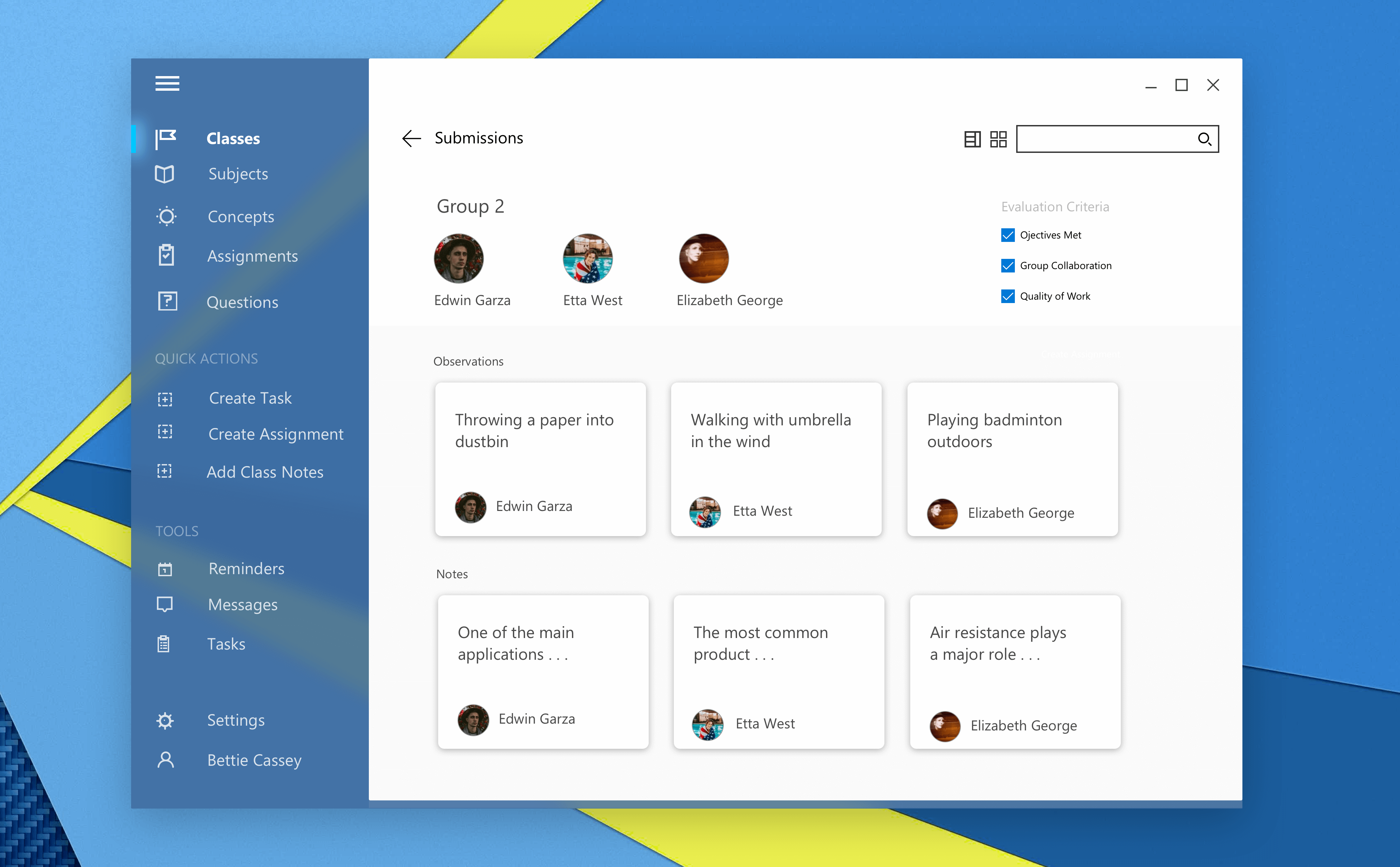
The teacher can view the various content submitted by each individual member of the group. Also, the teacher can “Check” if the required objectives are met and personalized evaluation criteria. However, teacher can view each entry and evaluate separately.
Comment and Pullout

Teacher view of the student’s submission. Students can also view each other’s submission unless the teacher has made an assignment specifically hidden. This way, students can give feedback easily and help each other, understand the concepts well.

Pullout for distraction free reading
Pen Support

Pen support for easy and e!ective evaluation. It is most suitable for classroom scenario
Adopting Fluent design
Material
I have used the translucent acrylic material for the side menu and secondary menu in decreasing order of transparency giving a sense of hierarchy. Content is always opaque.
Light
Whenever users hover through the menu there will be a highlight over the edges of the label, this helps in knowing where they are without interacting fully with the element. I have used it for the menu selection and selecting items.
Color
Whenever users hover through the menu there will be a highlight over the edges of the label, this helps in knowing where they are without interacting fully with the element.
I have used it for the menu selection and selecting items.
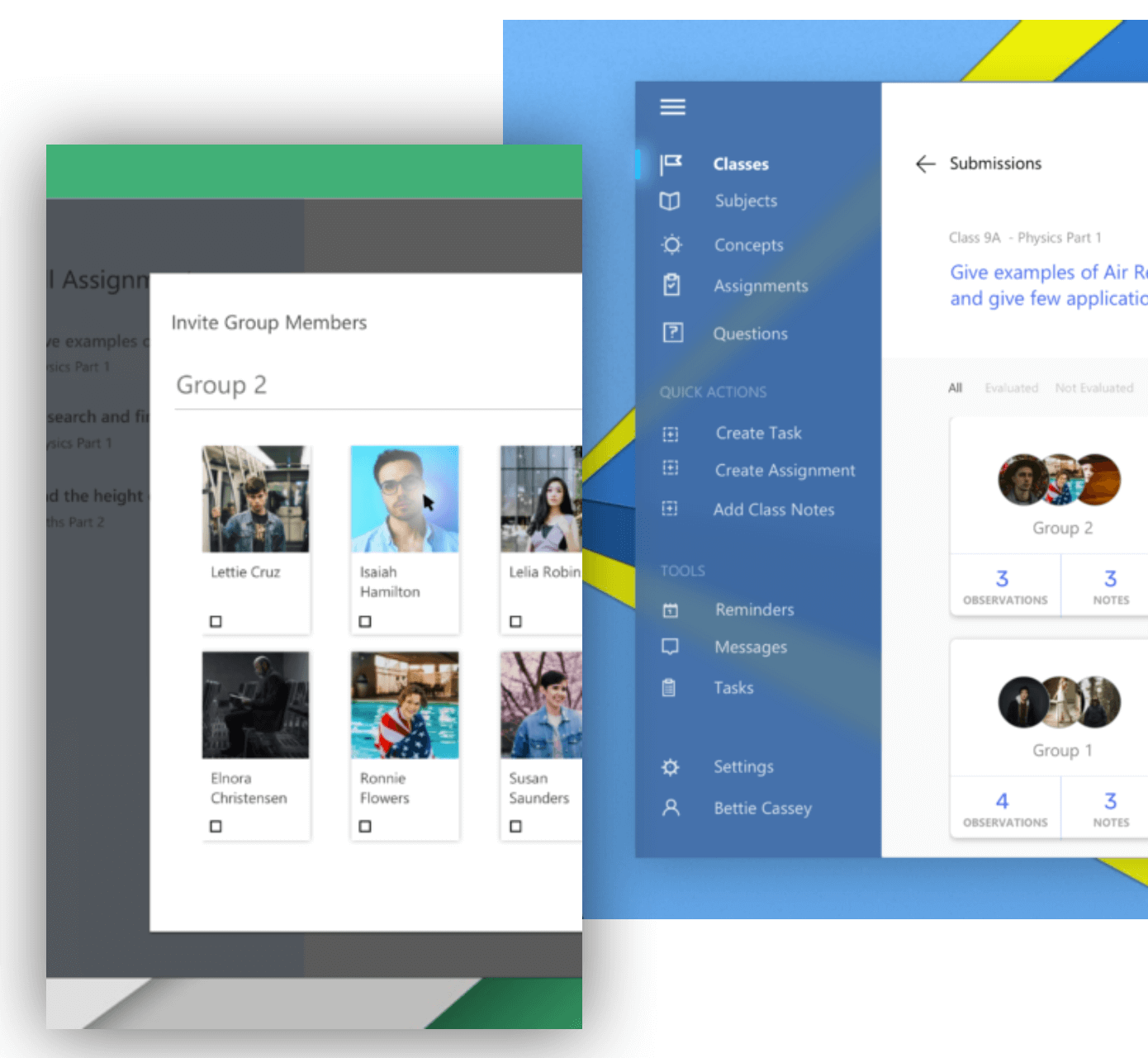
Translucent Acrylic Side Menu and Light focusing pointer
THE FUTURE
Stretch Goals
I can further work on more scenarios of how Reminders can help the students manage their day to day activities and yet
stay focused on the work at hand.
I also would like to go deep into how systems can be built to
improve questioning and observation skills of students. How this digital companion can aid the students in probing,connecting dots while experiencing day to day phenomenon.
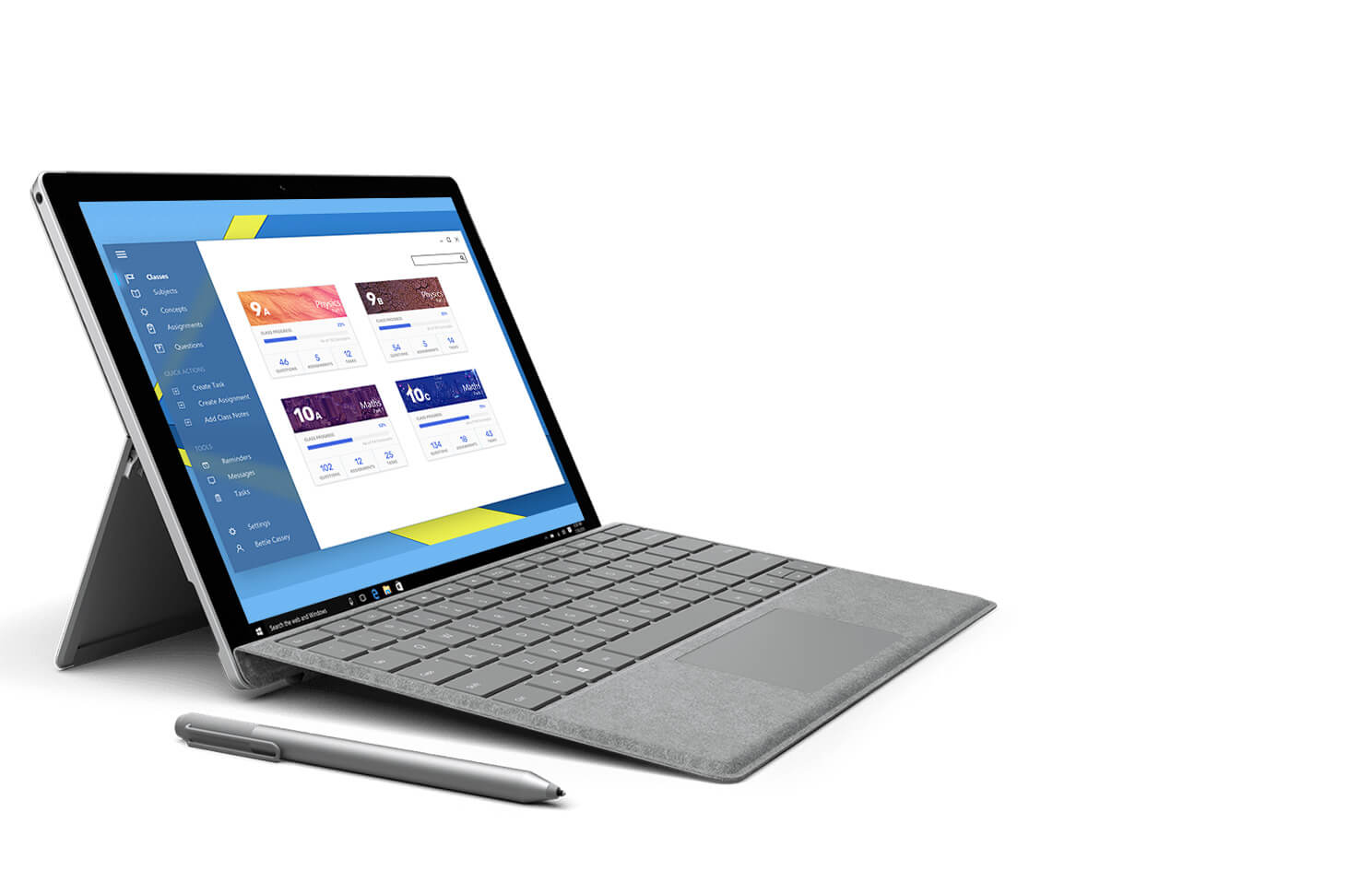
Overall it has been an enriching experience working on this project. It was challenging to convert the struggles of
classroom education and disadvantages of a school diary to a broader and holistic solution solving the core issues around
modern day schools and enabling students and teachers to be part of the much needed digital transformation.




